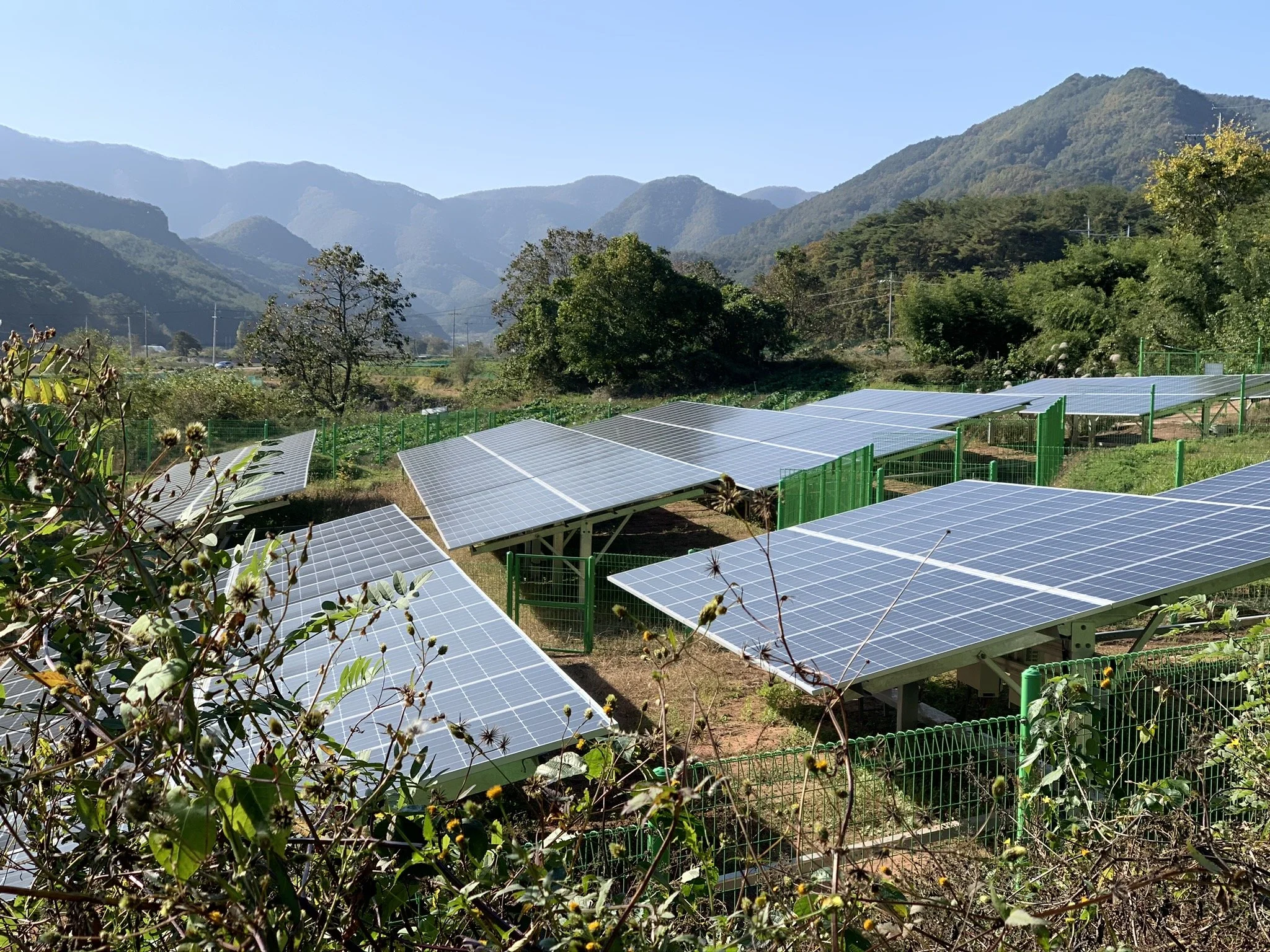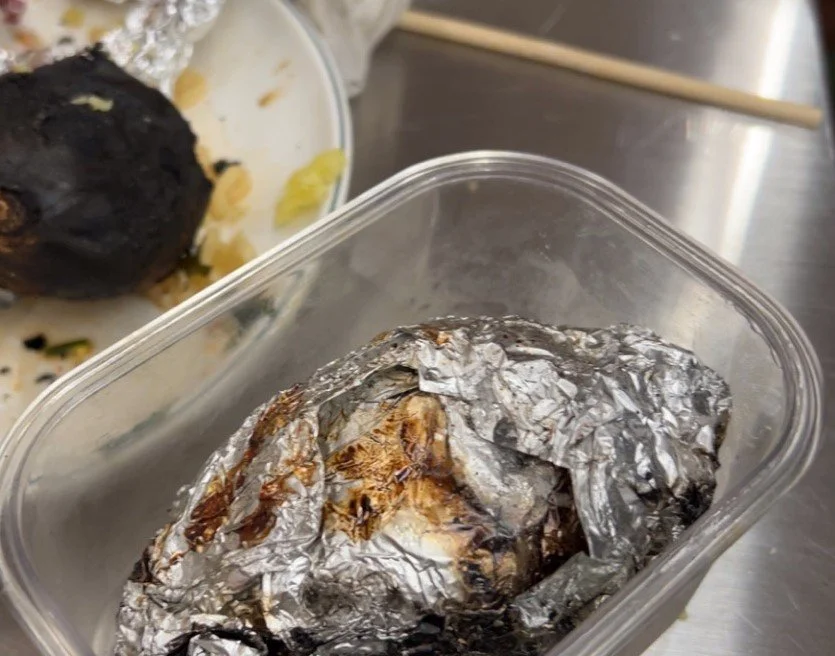For Our Greener Future
The UN has established 17 sustainable development goals to make the world a preferable place for future generations. These goals are known as SDG’s and accentuate global issues such as poverty, gender equality, and more. Among the many different purposes that the United Nations proposed, goal number 13, climate change has been a controversial and eye-opening issue in contemporary society. Climate change mainly underscores the shift in global climates due to the increased levels of CO2 emissions in the Earth’s atmosphere. While this concept might not be so apparent in today’s world, it is slowly but certainly affecting us in a derogatory manner. As a result, the ski industry is also declining. To prevent our favorite sport from disappearing due to Global warming, we take interest in our environments and actively participate in climate change prevention activities.
Education for Climate Change
Every year, we provide environmental education to children at the Northern Gyeonggi Foster Child Center about what we can do to combat climate change.


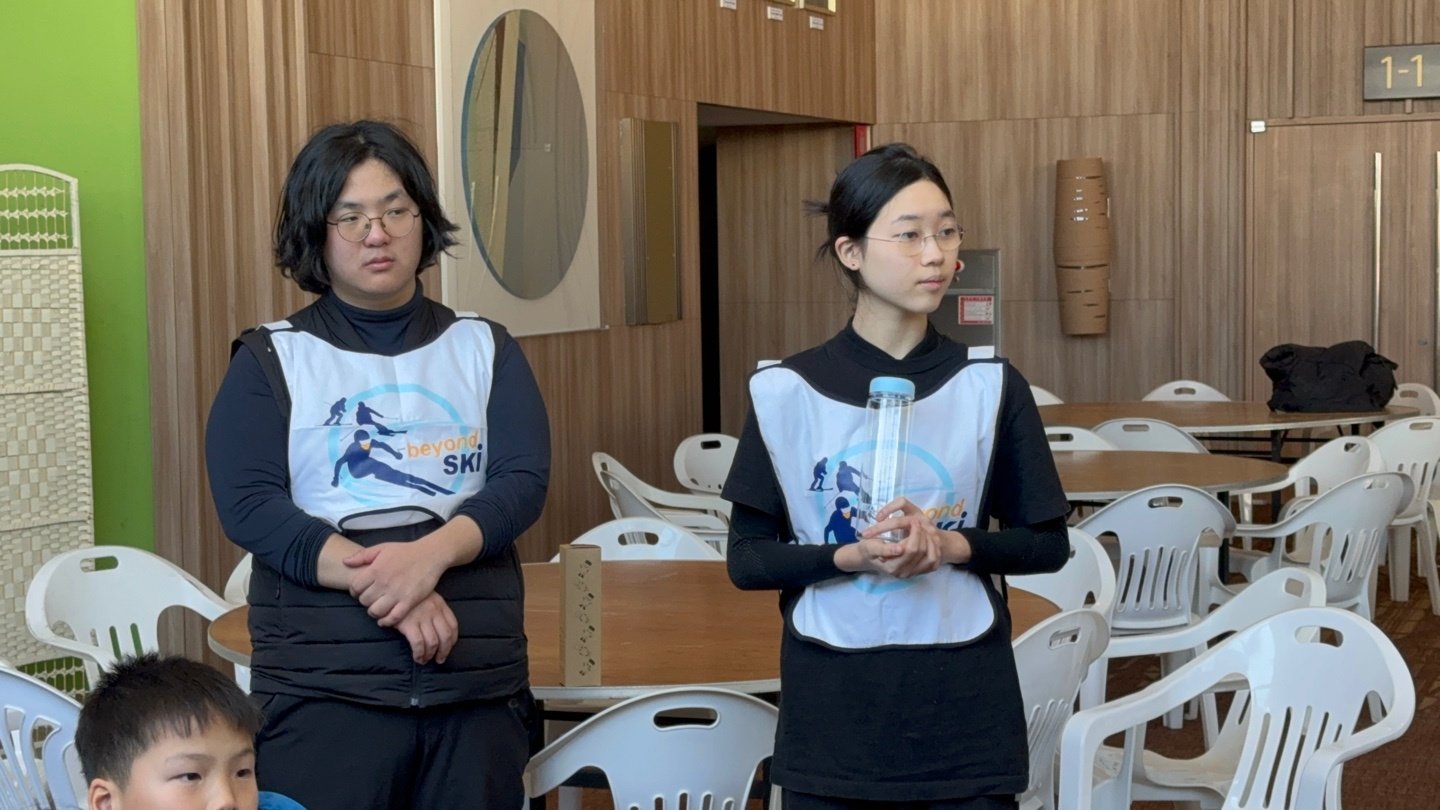

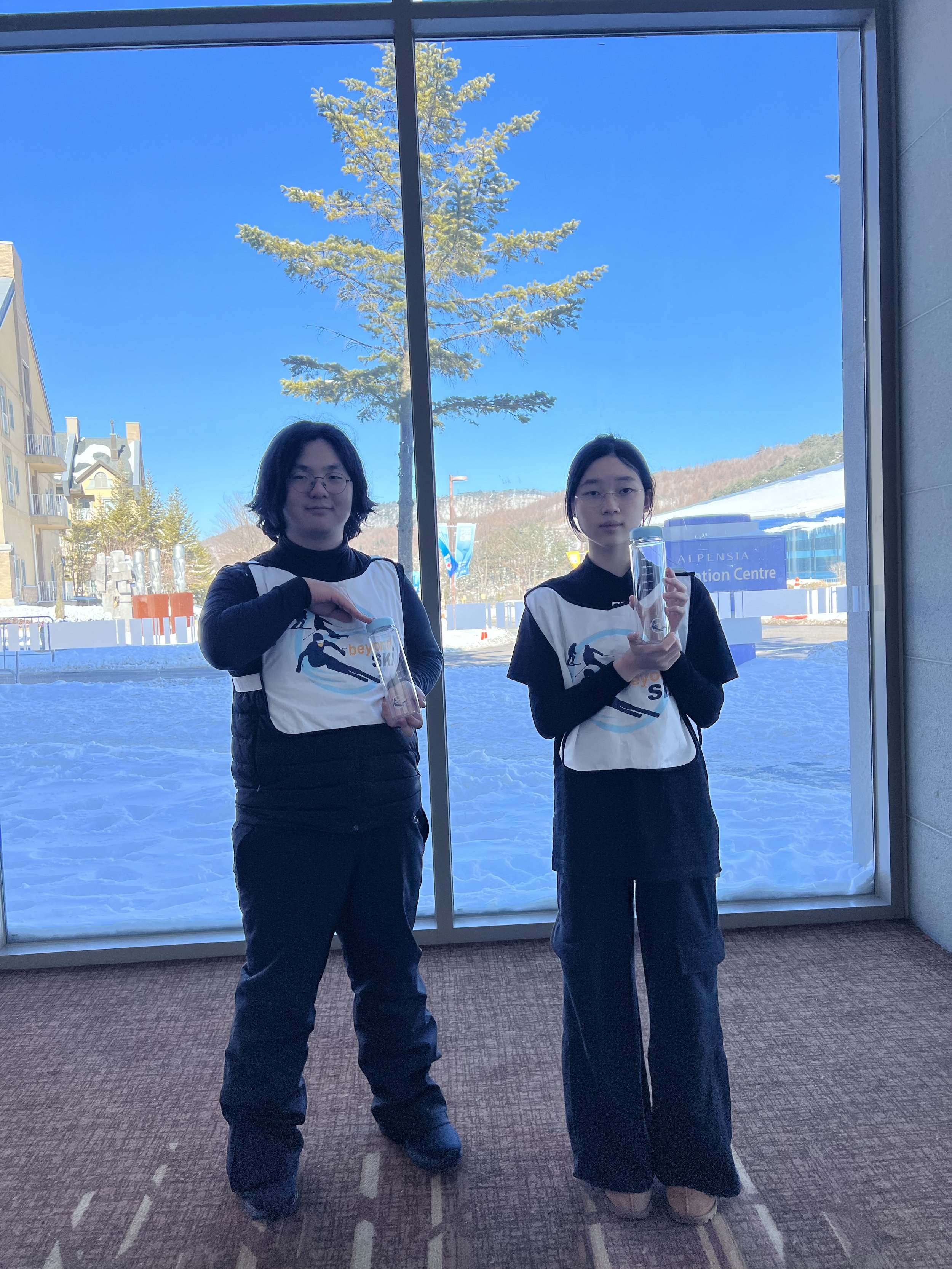
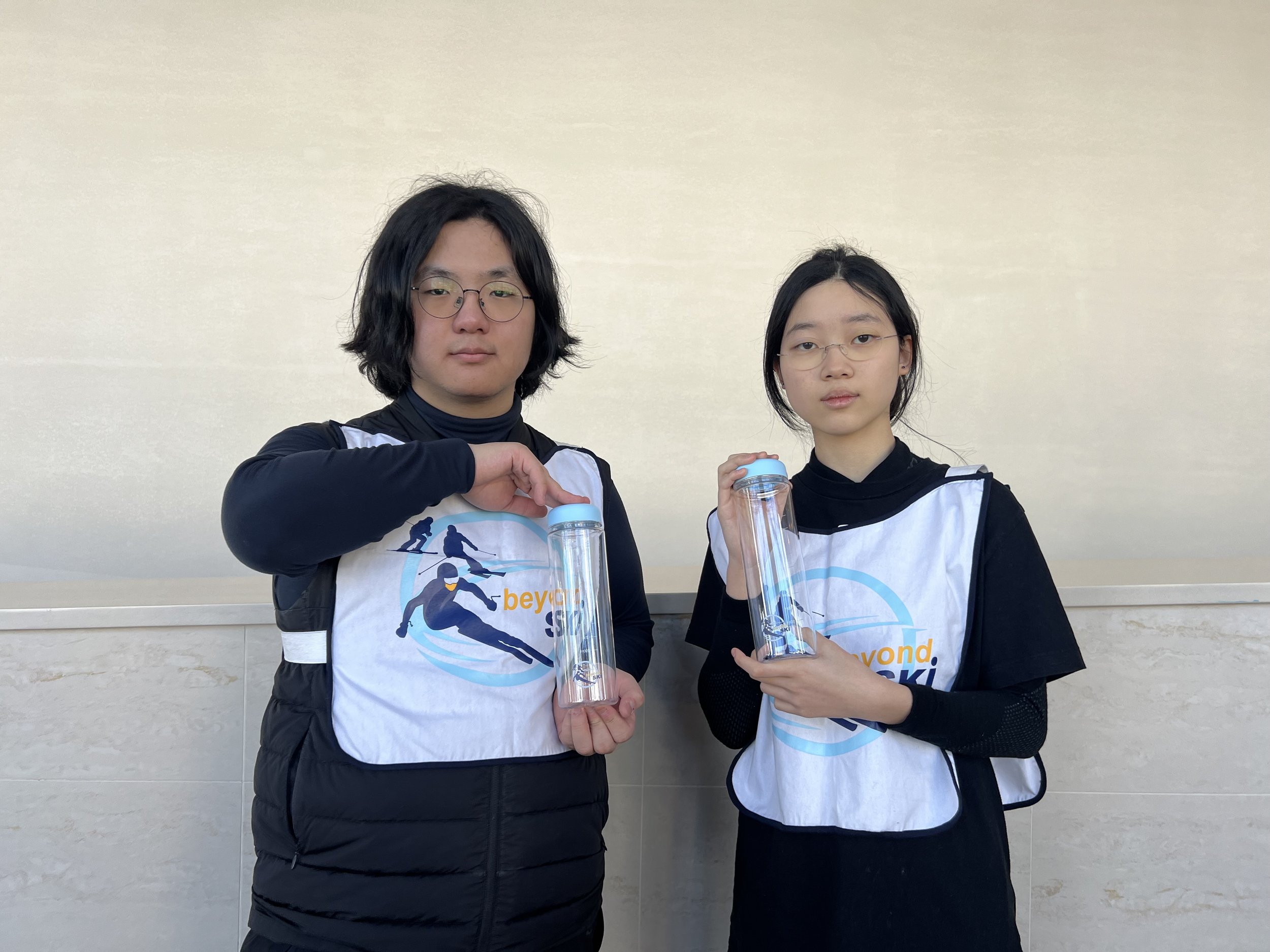
Reusable Water Bottle Campaign
We have designed our own eco-friendly water bottles and are running a campaign to use reusable water bottle. We sell water bottles at bazaar or social events and use the proceeds to fund "Beyond Ski Winter Ski Camp."
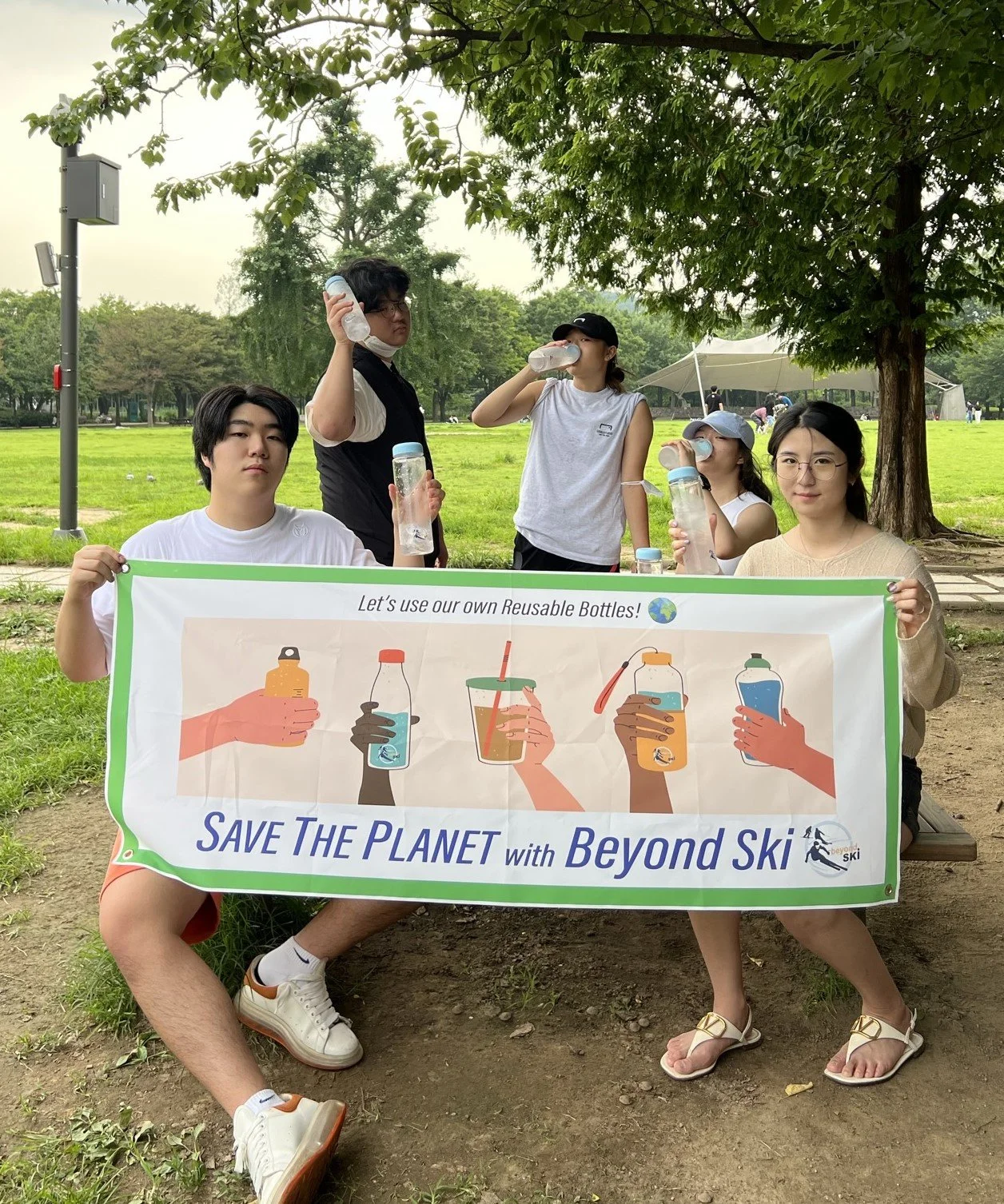
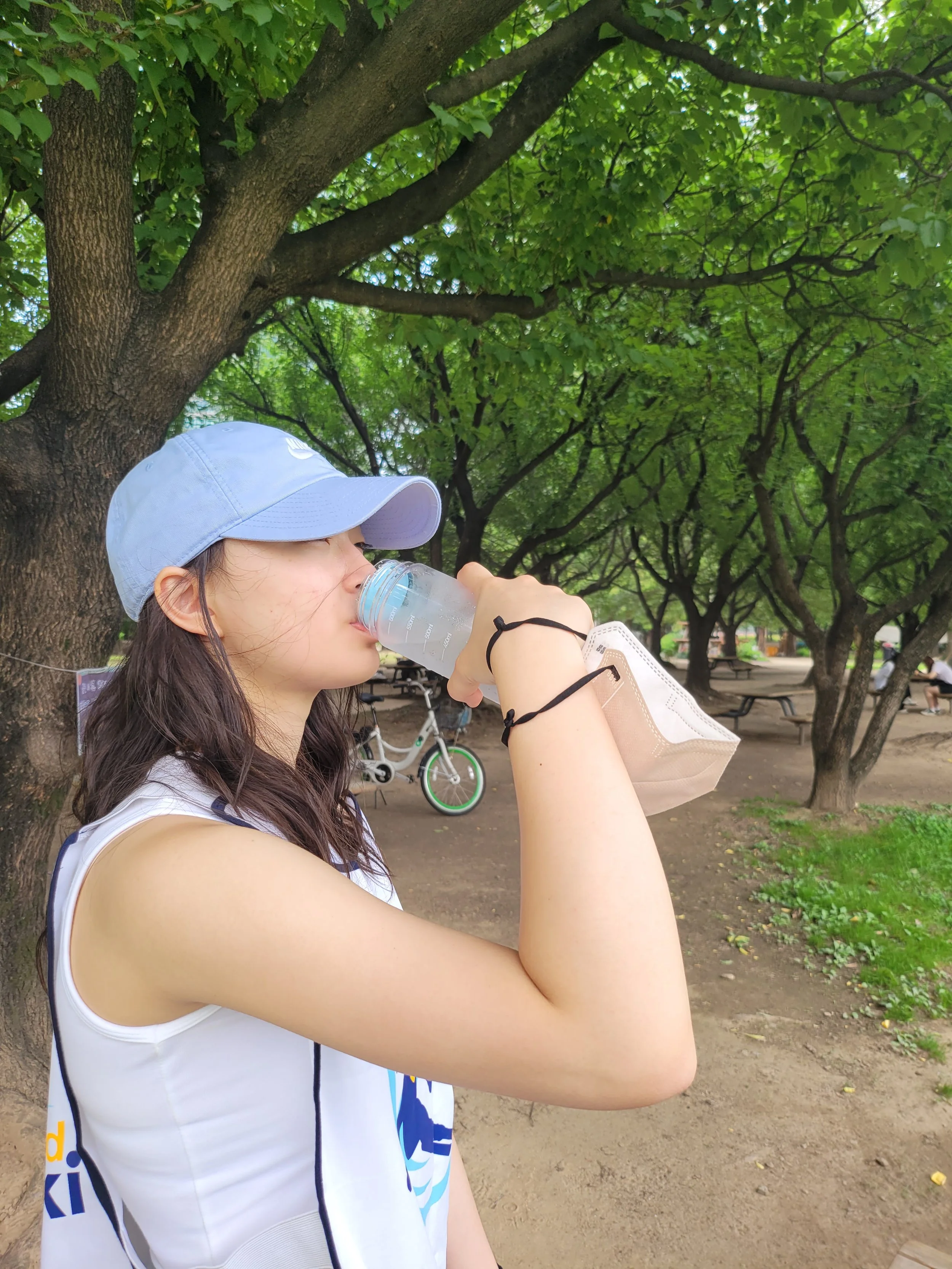

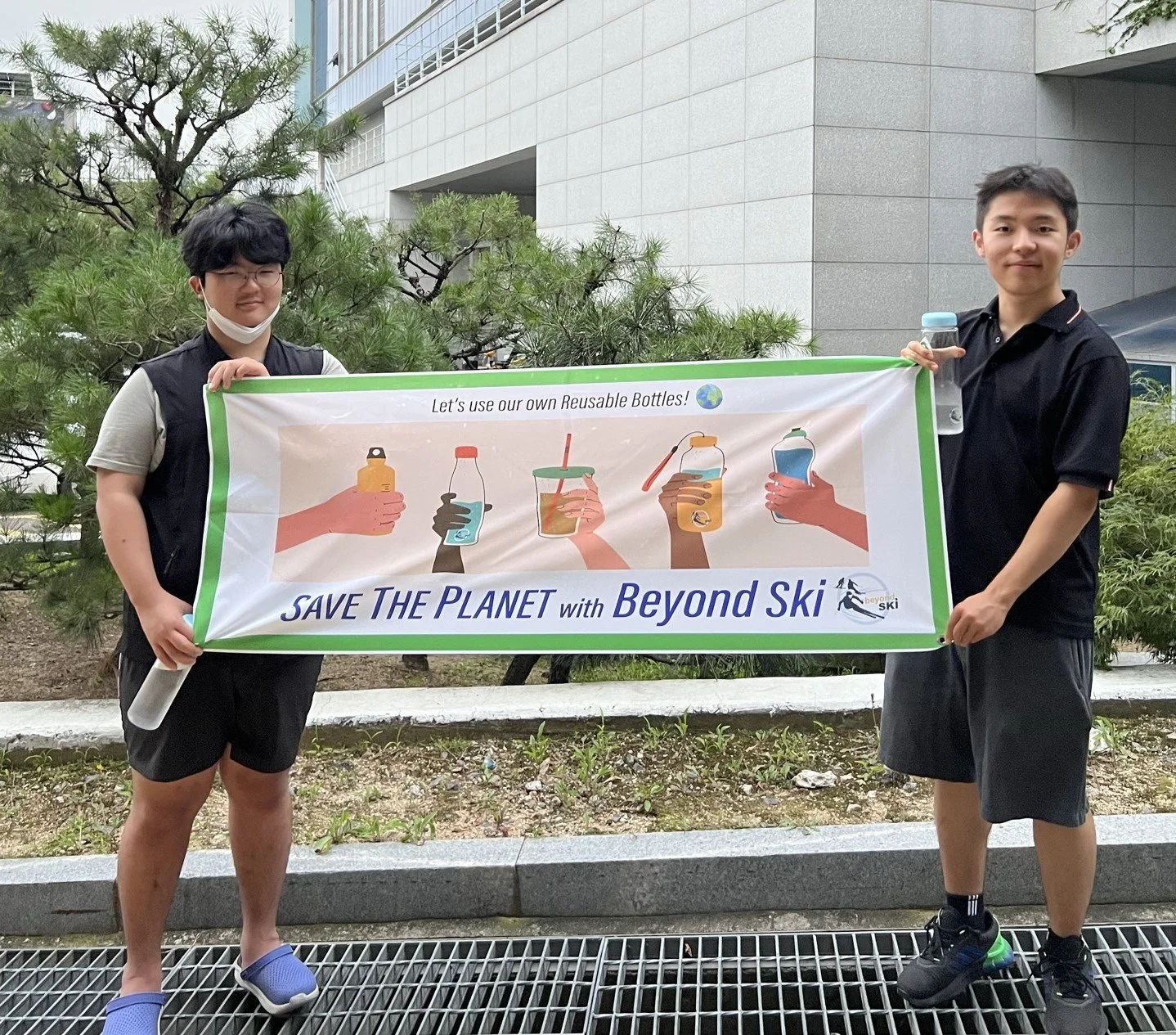
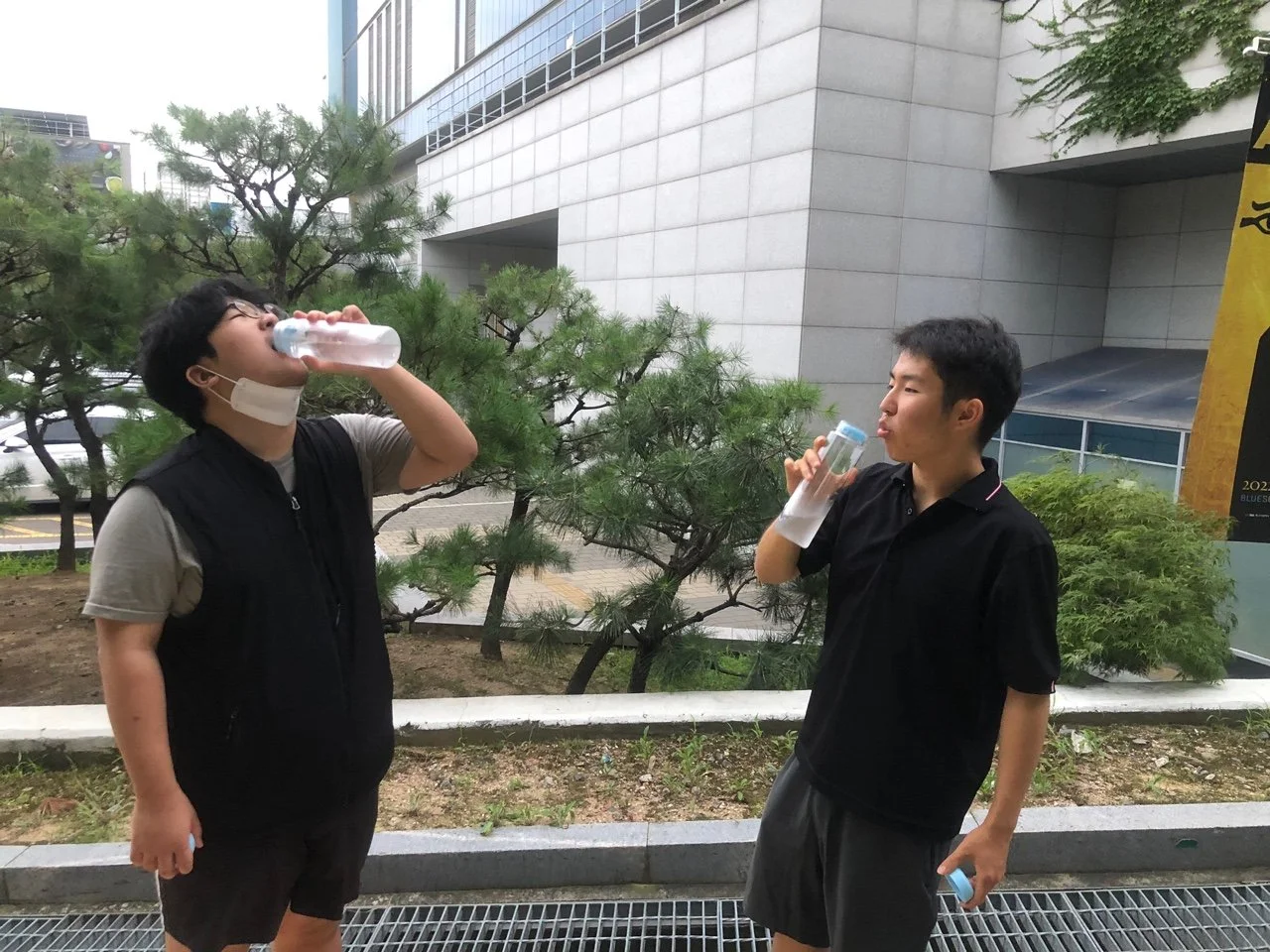
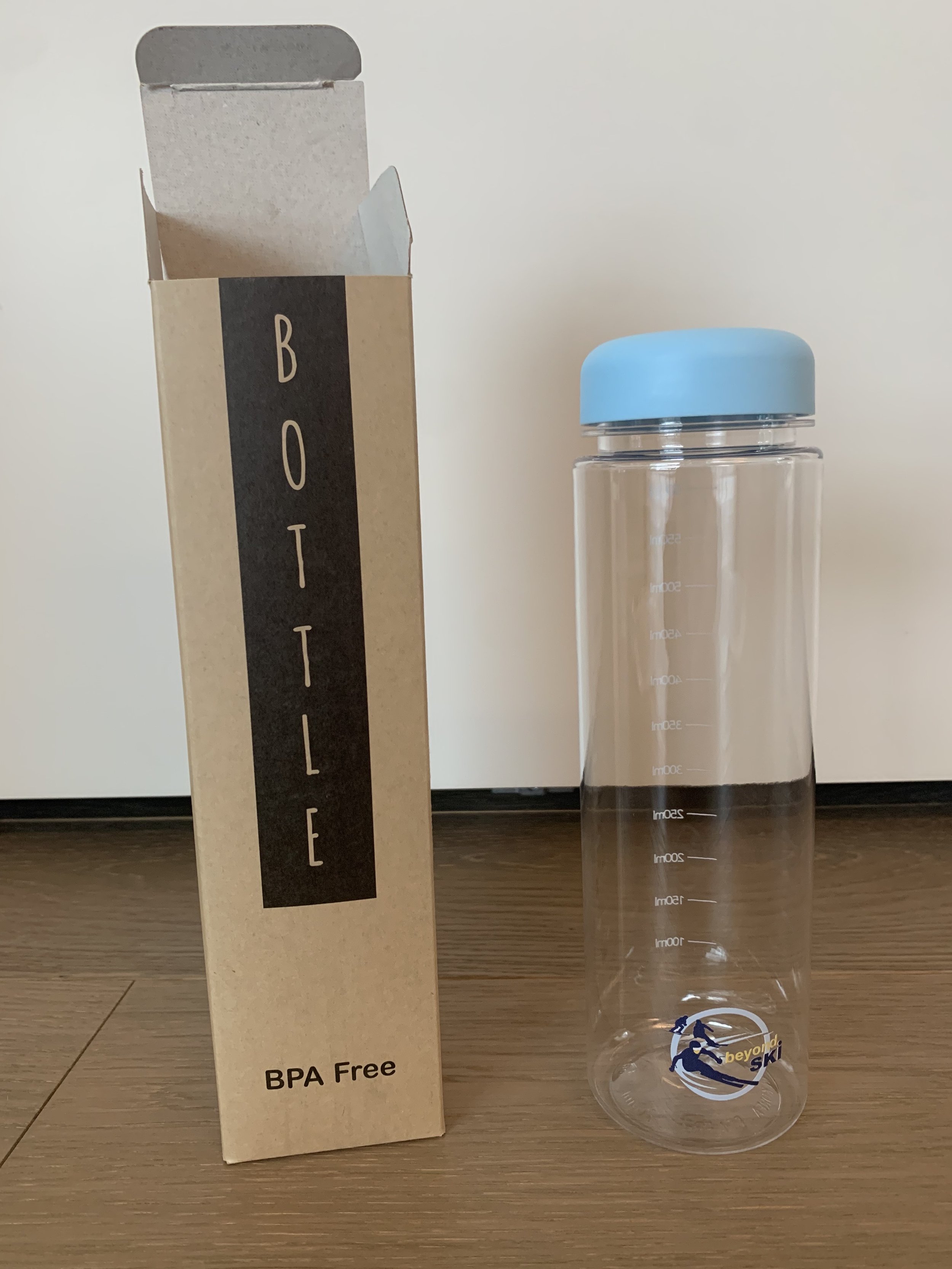
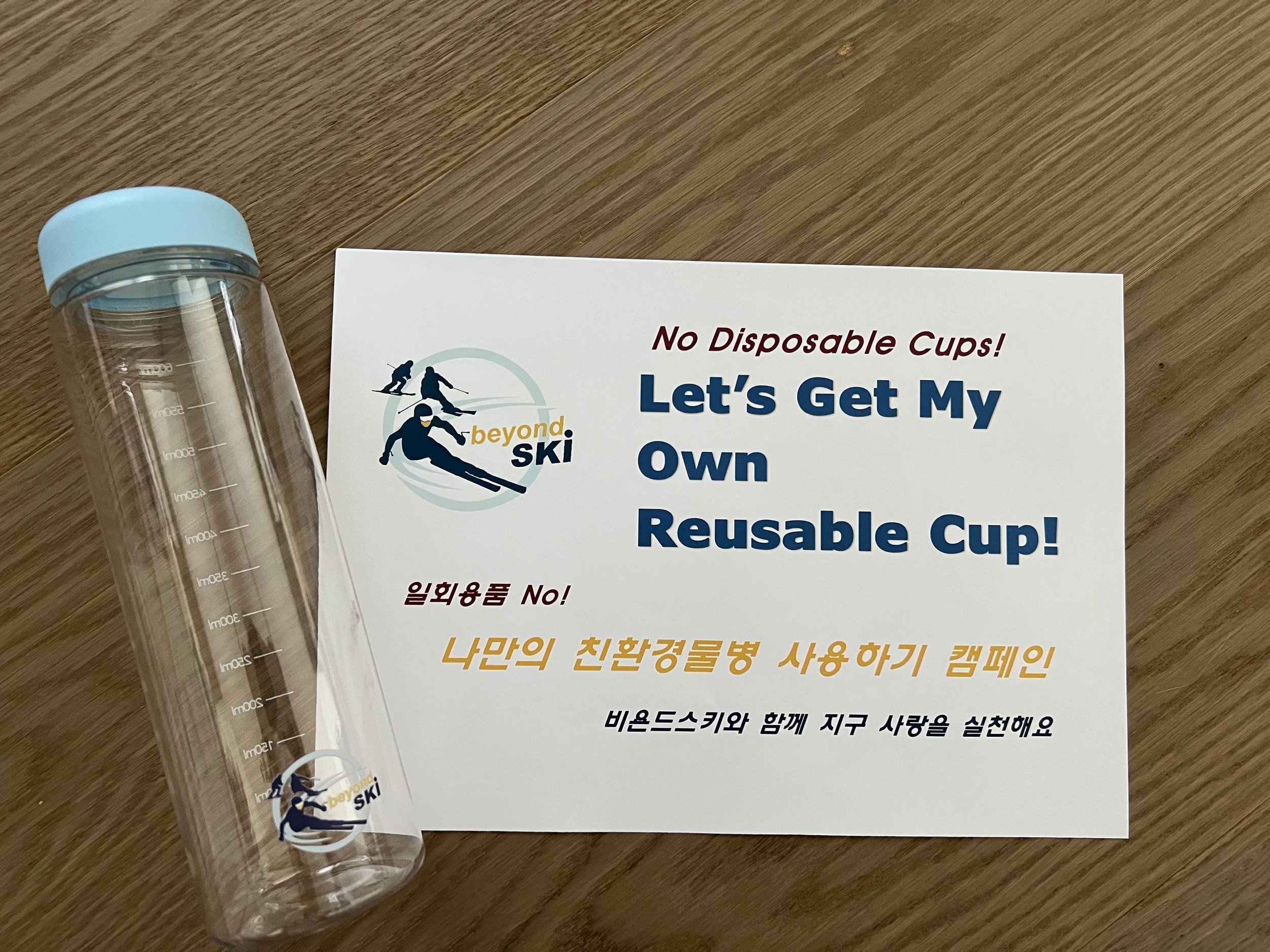
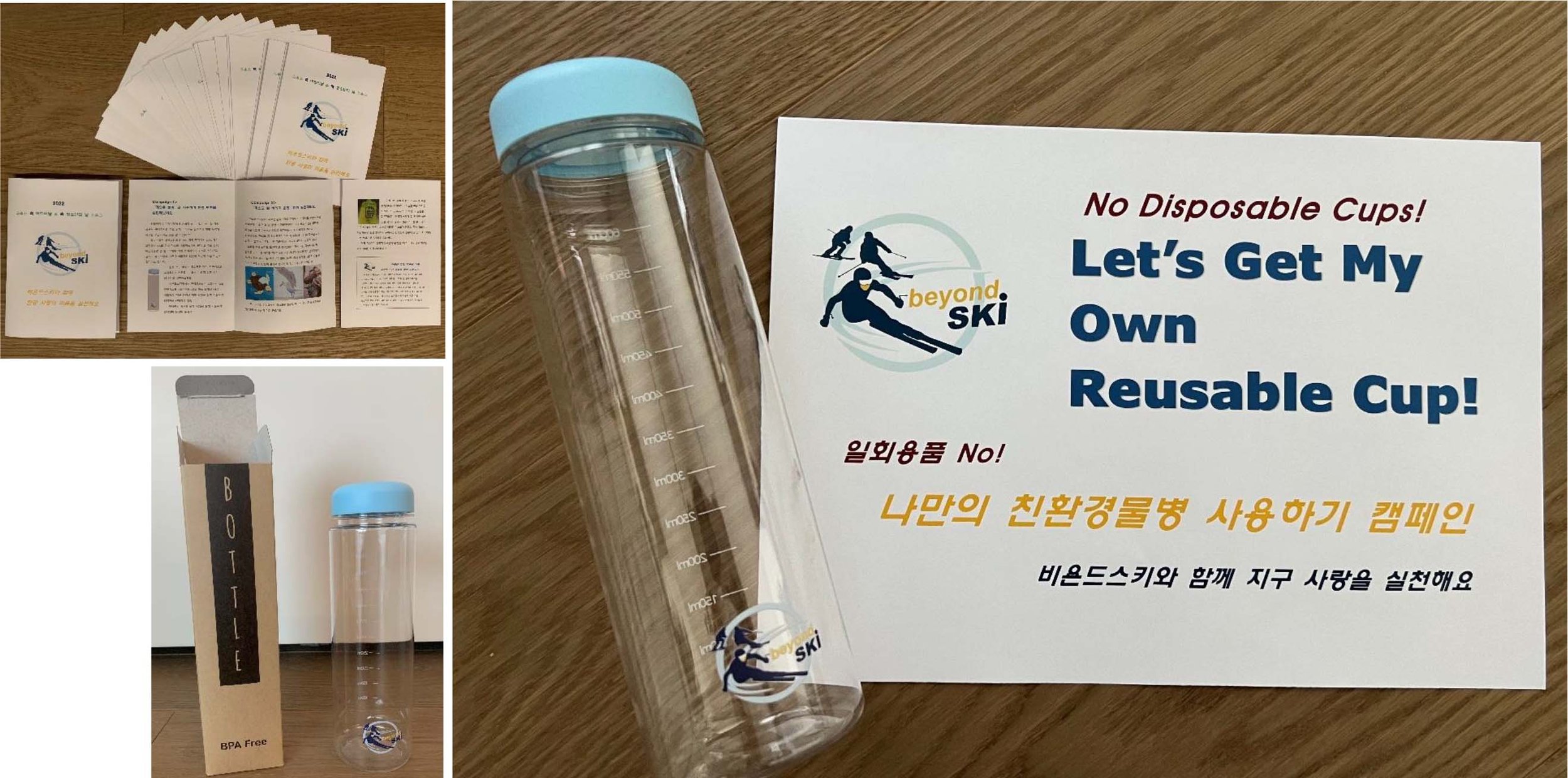


Plogging with Beyond Ski
Plogging is the noun form of the term plogga, which is a combination of the Swedish words plocka up (to pick up) and jogga (to jog), meaning "to jog while picking up trash". It is an environmental protection movement that involves picking up trash that you see while jogging, with the aim of taking care of your health through exercise and taking small actions to protect the environment.
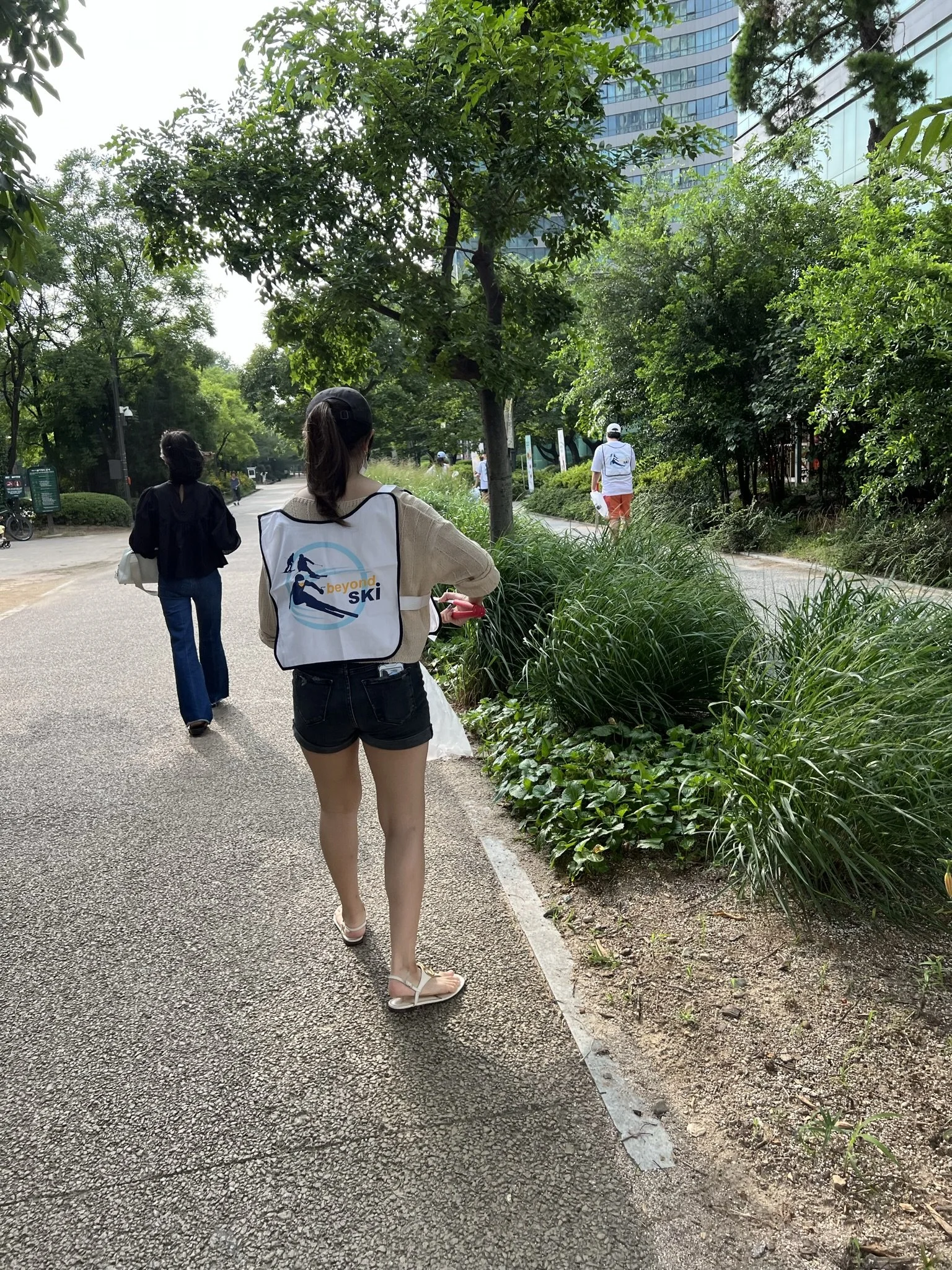
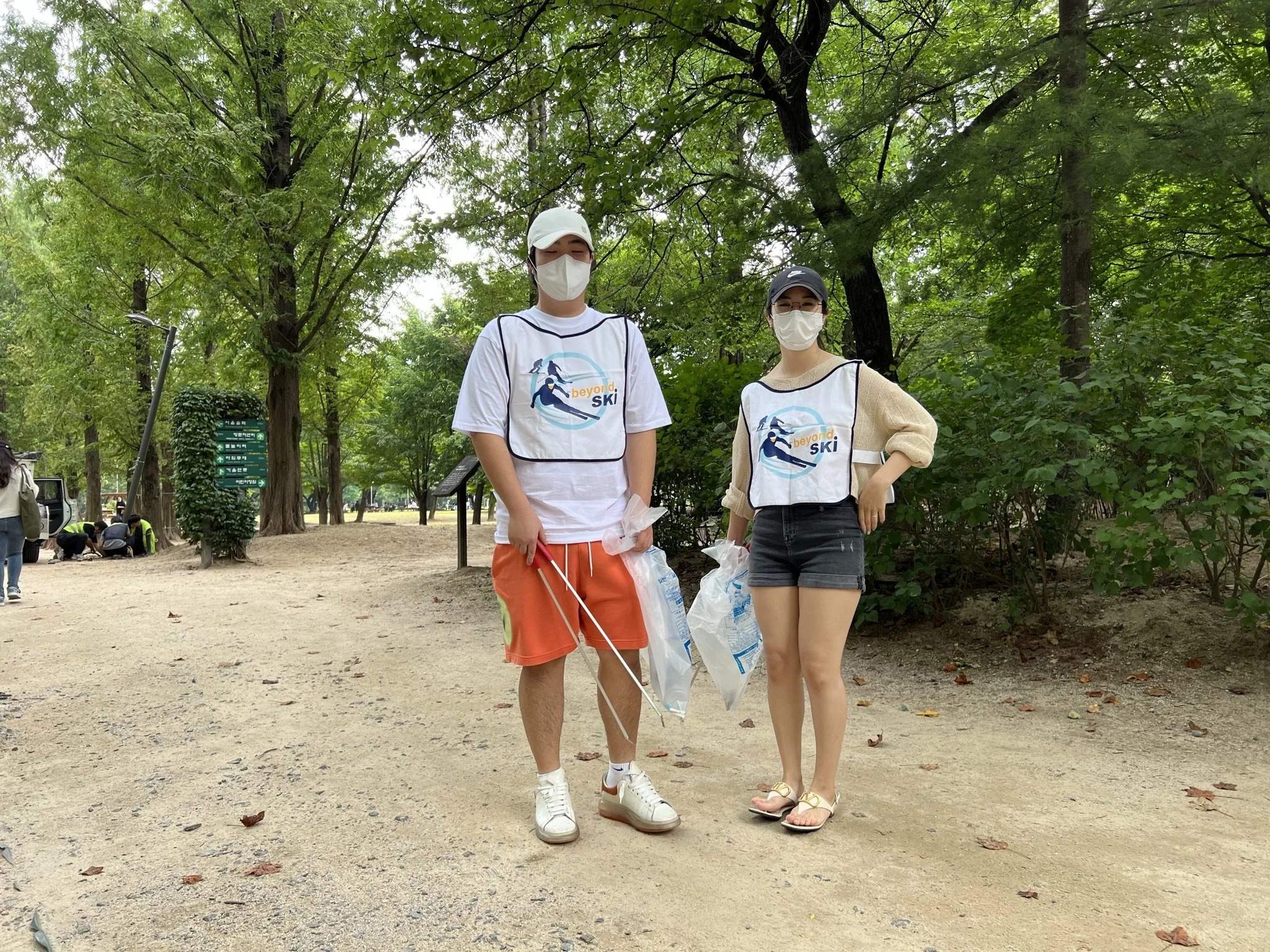
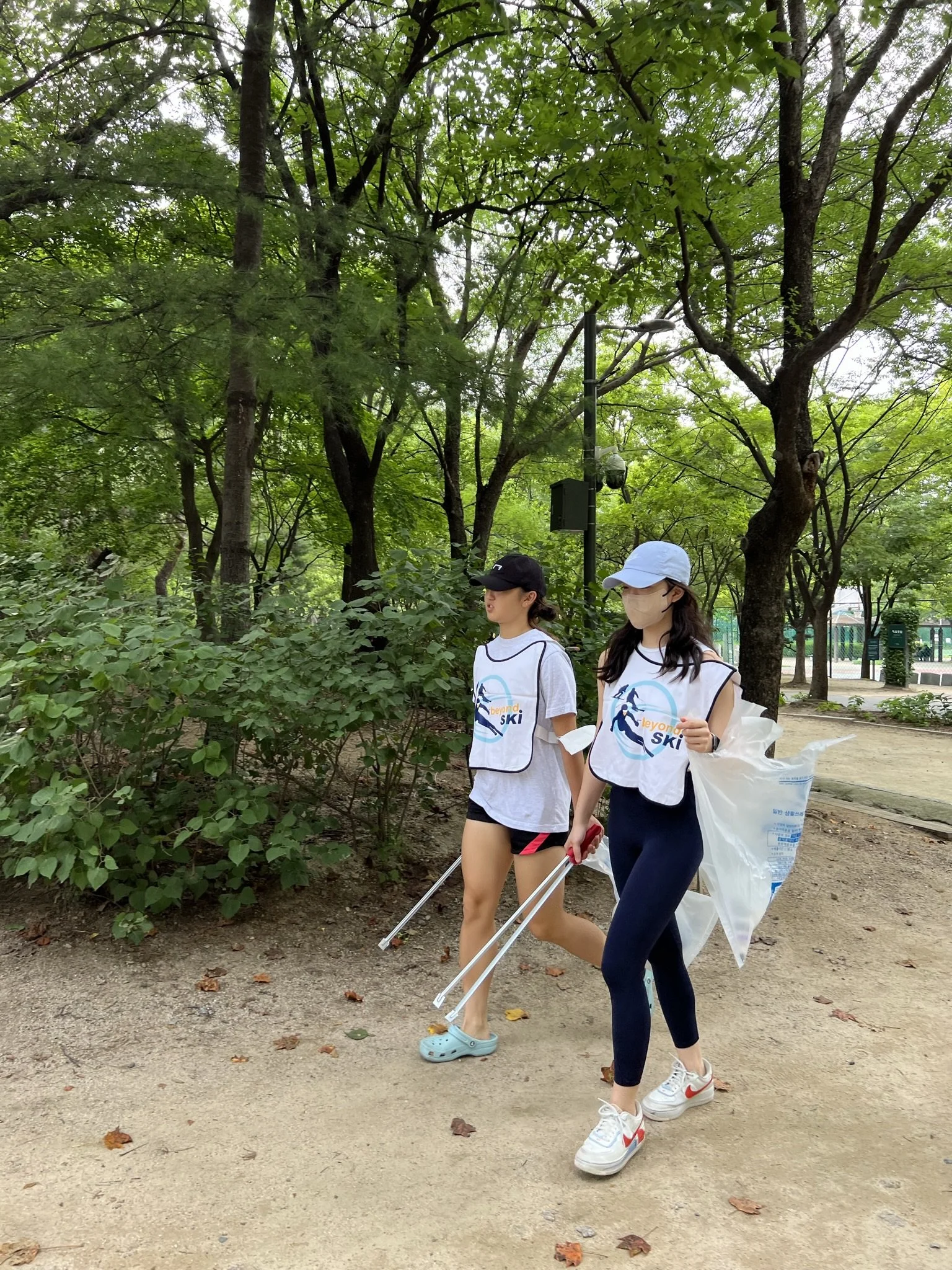
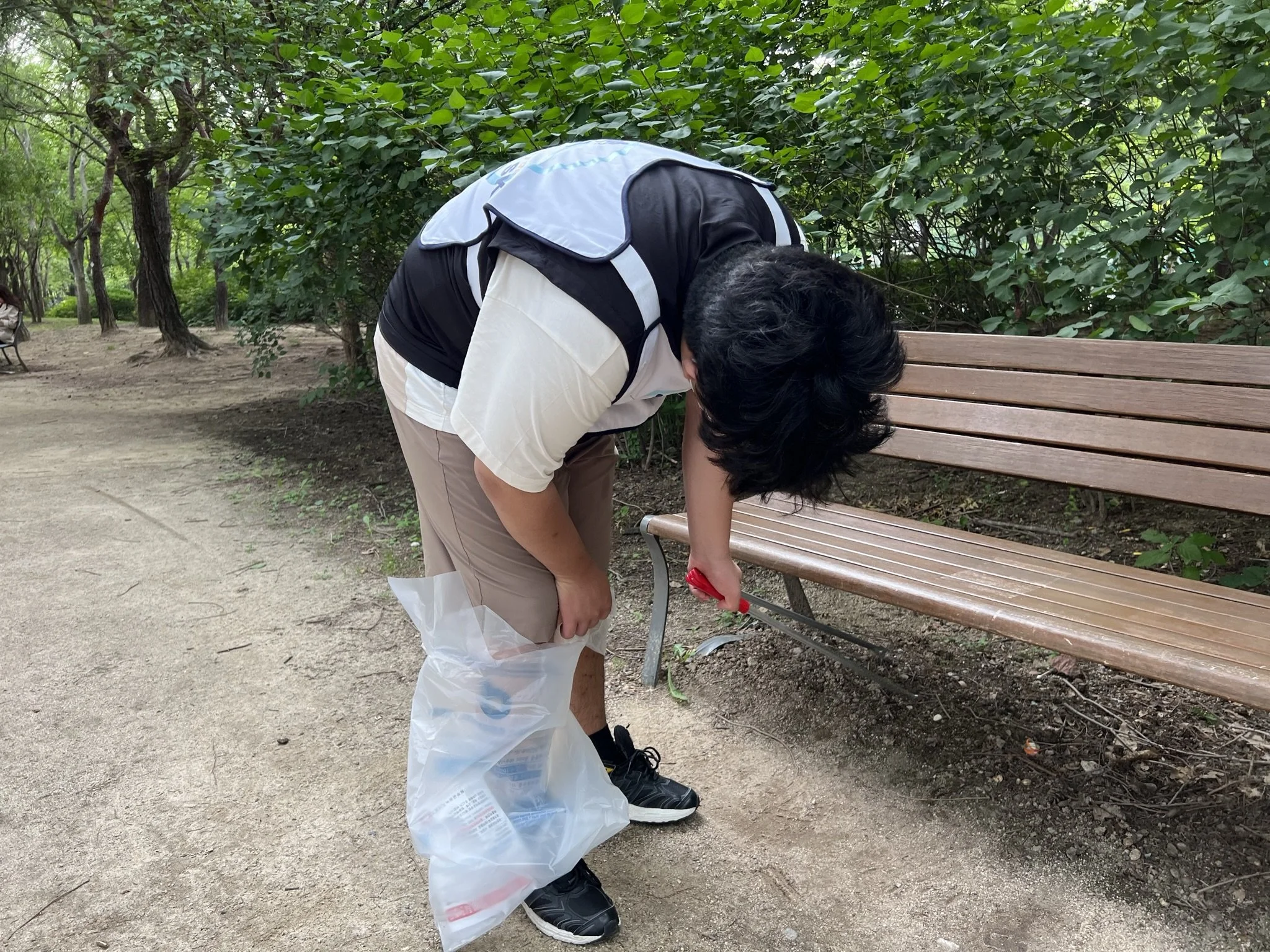
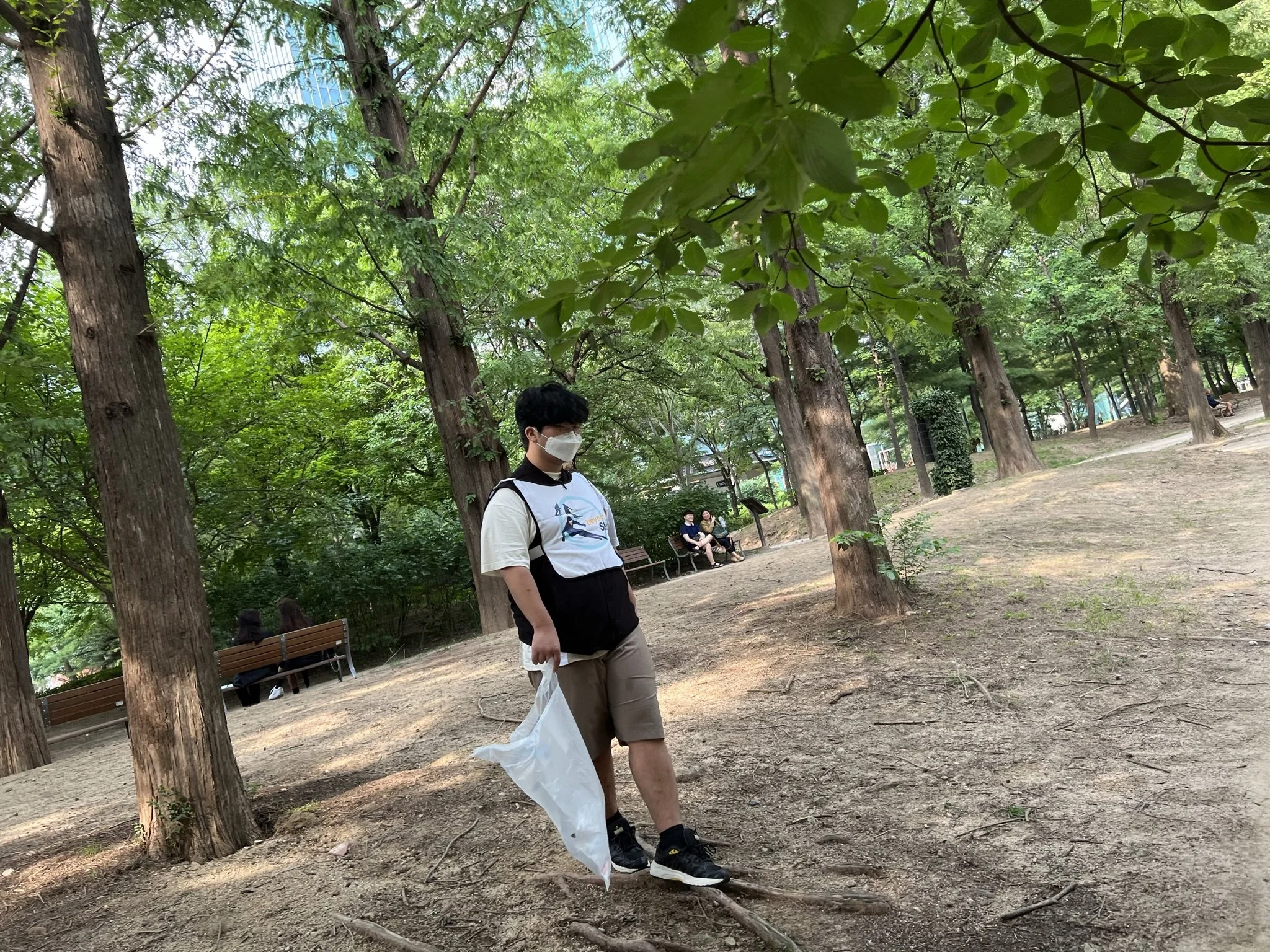
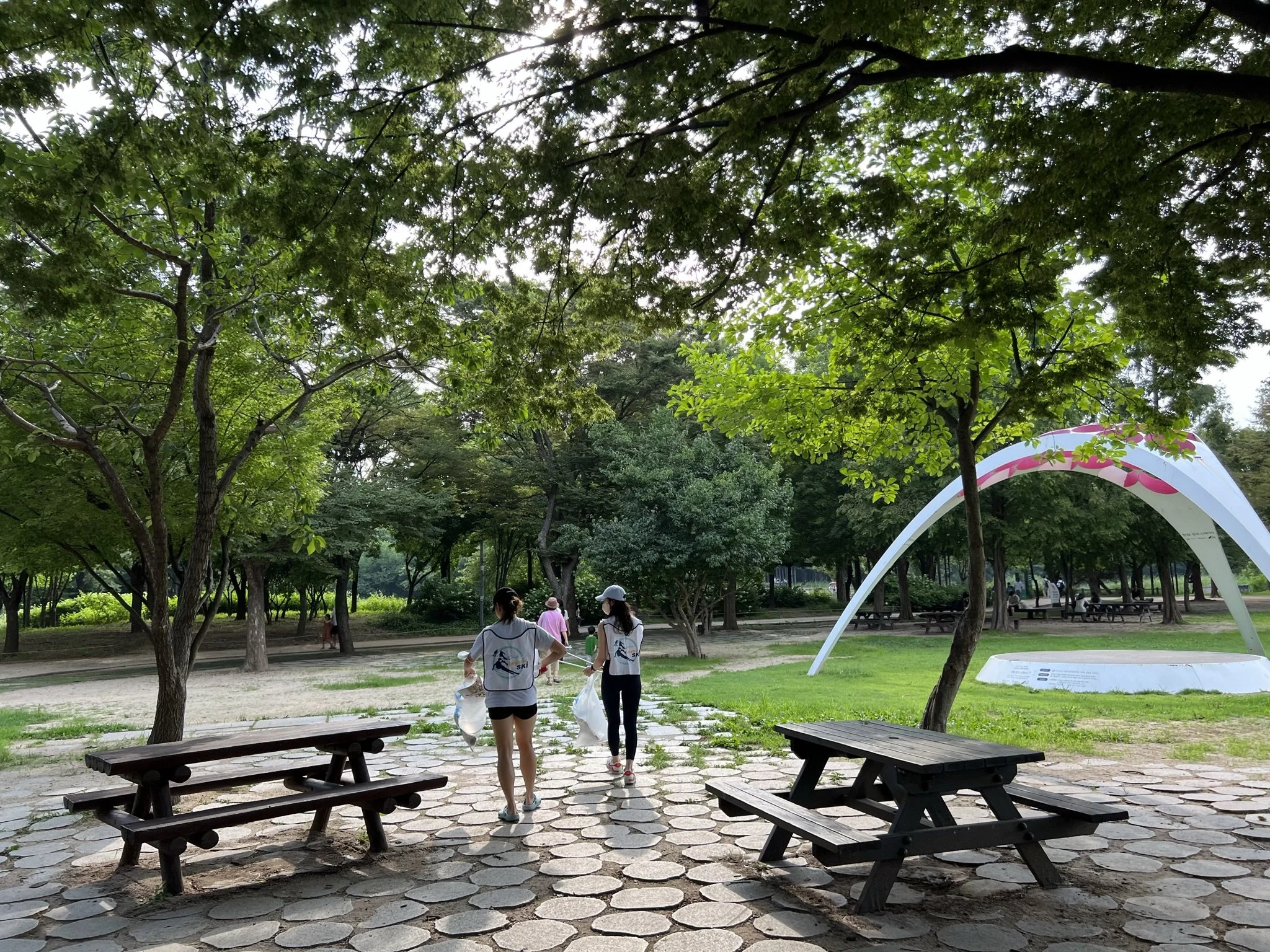
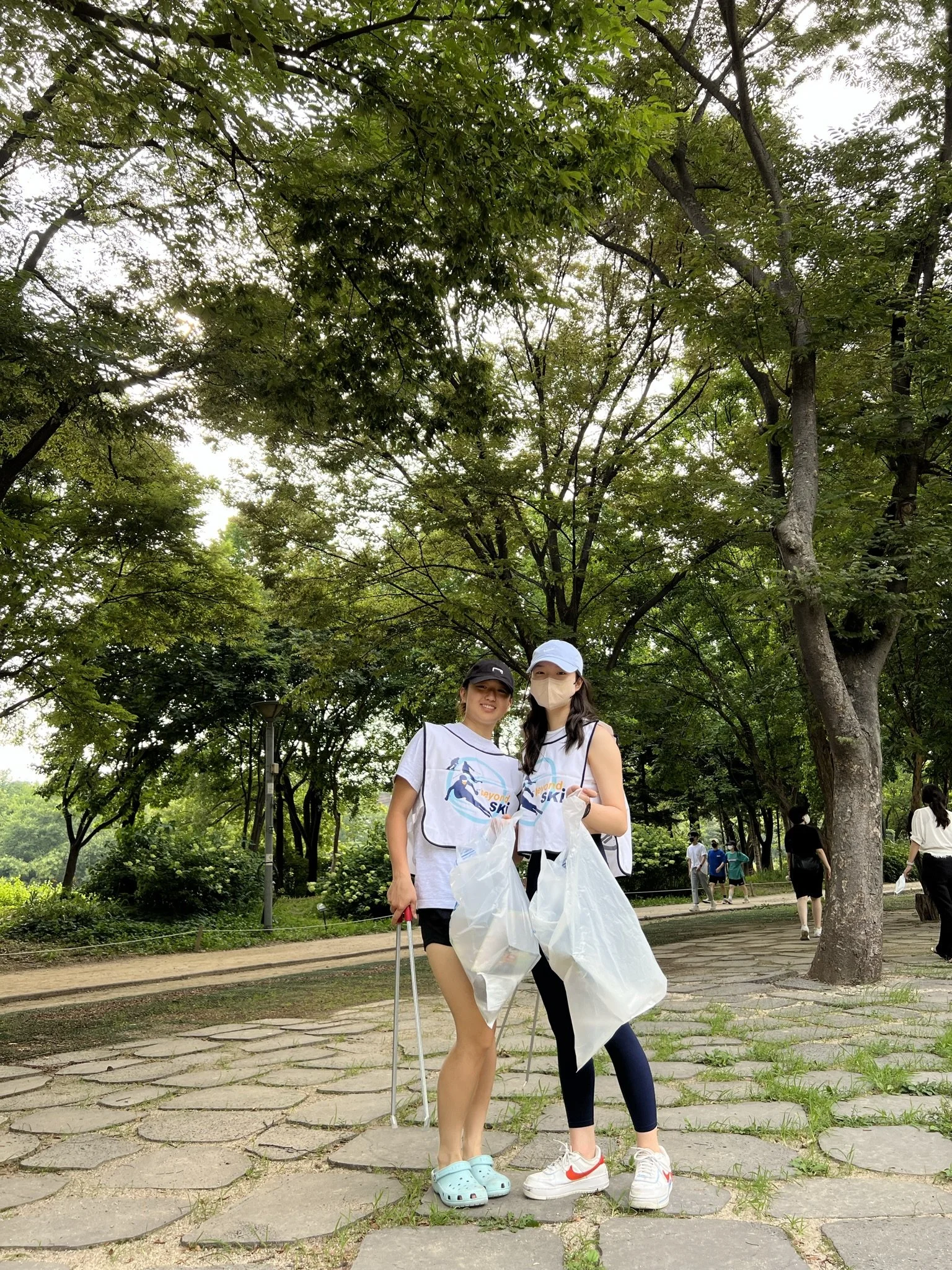
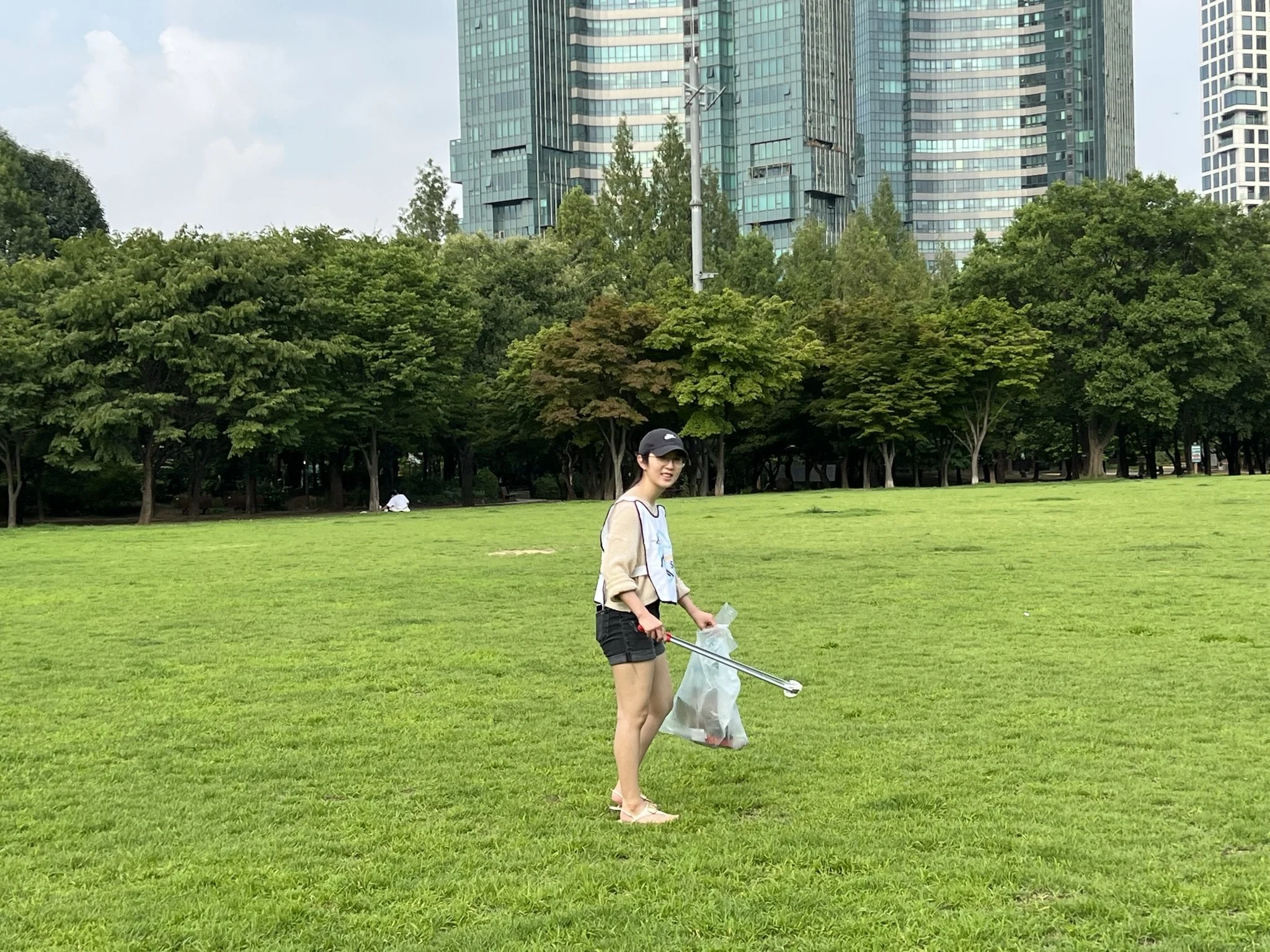
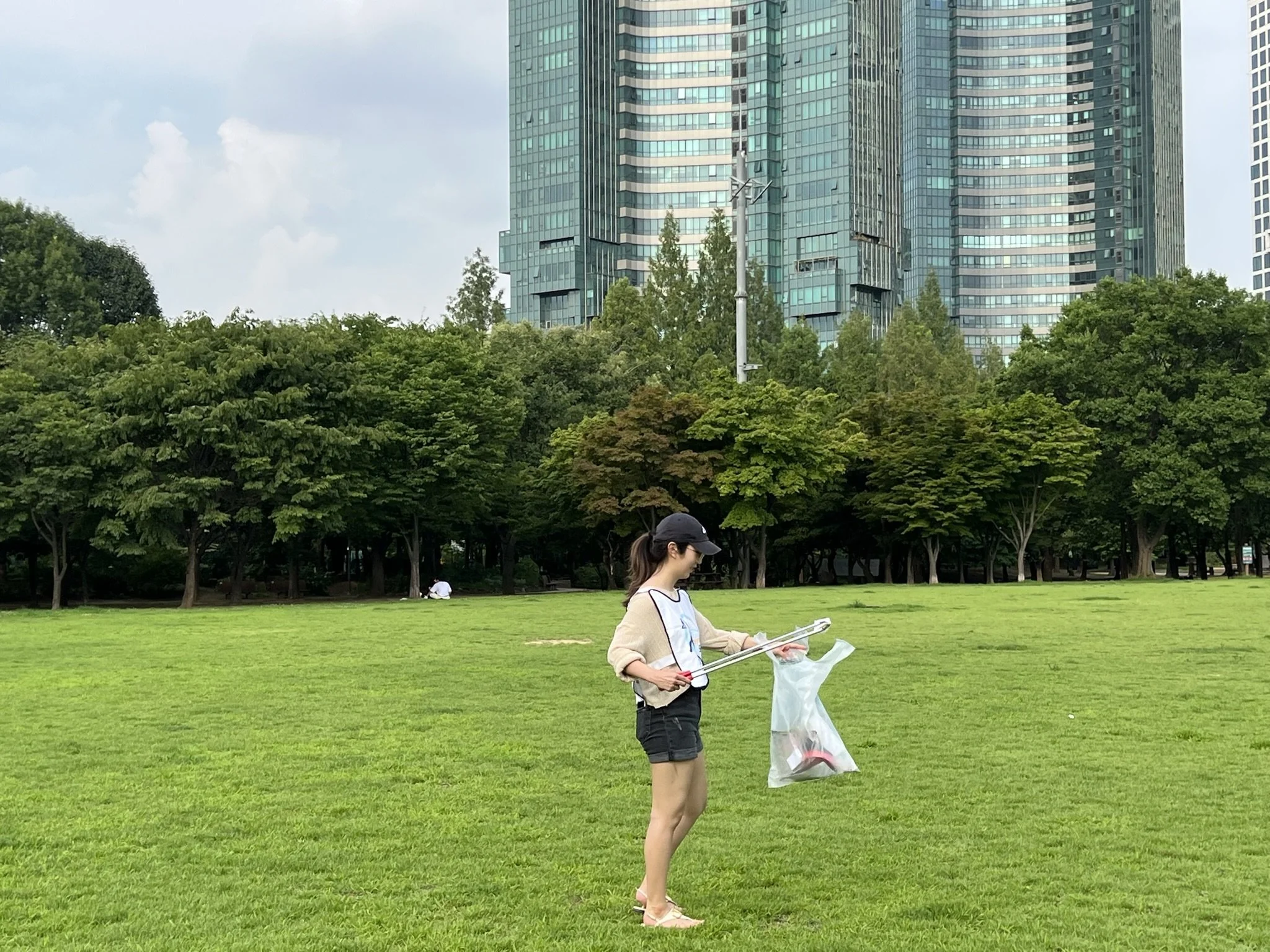
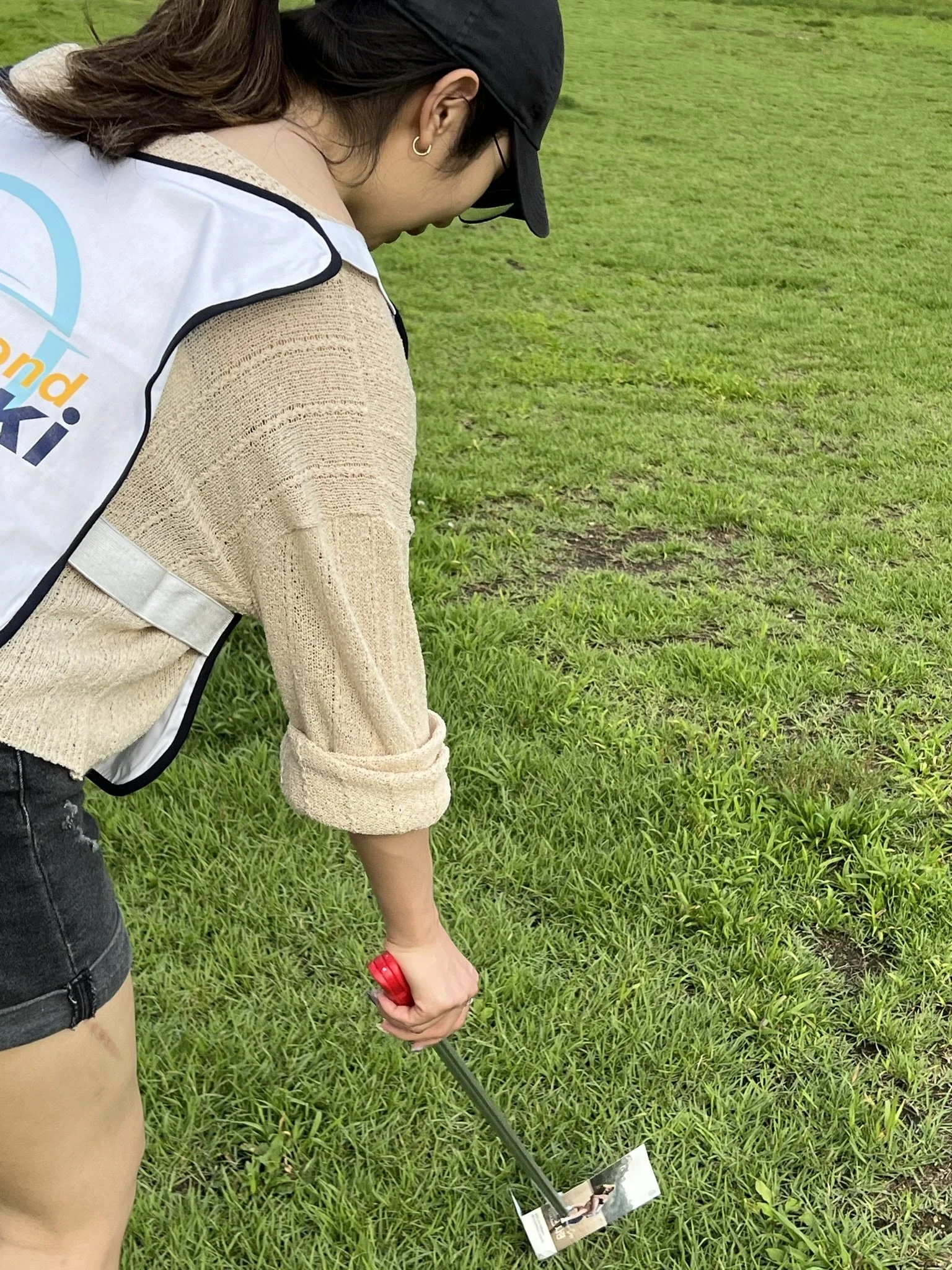
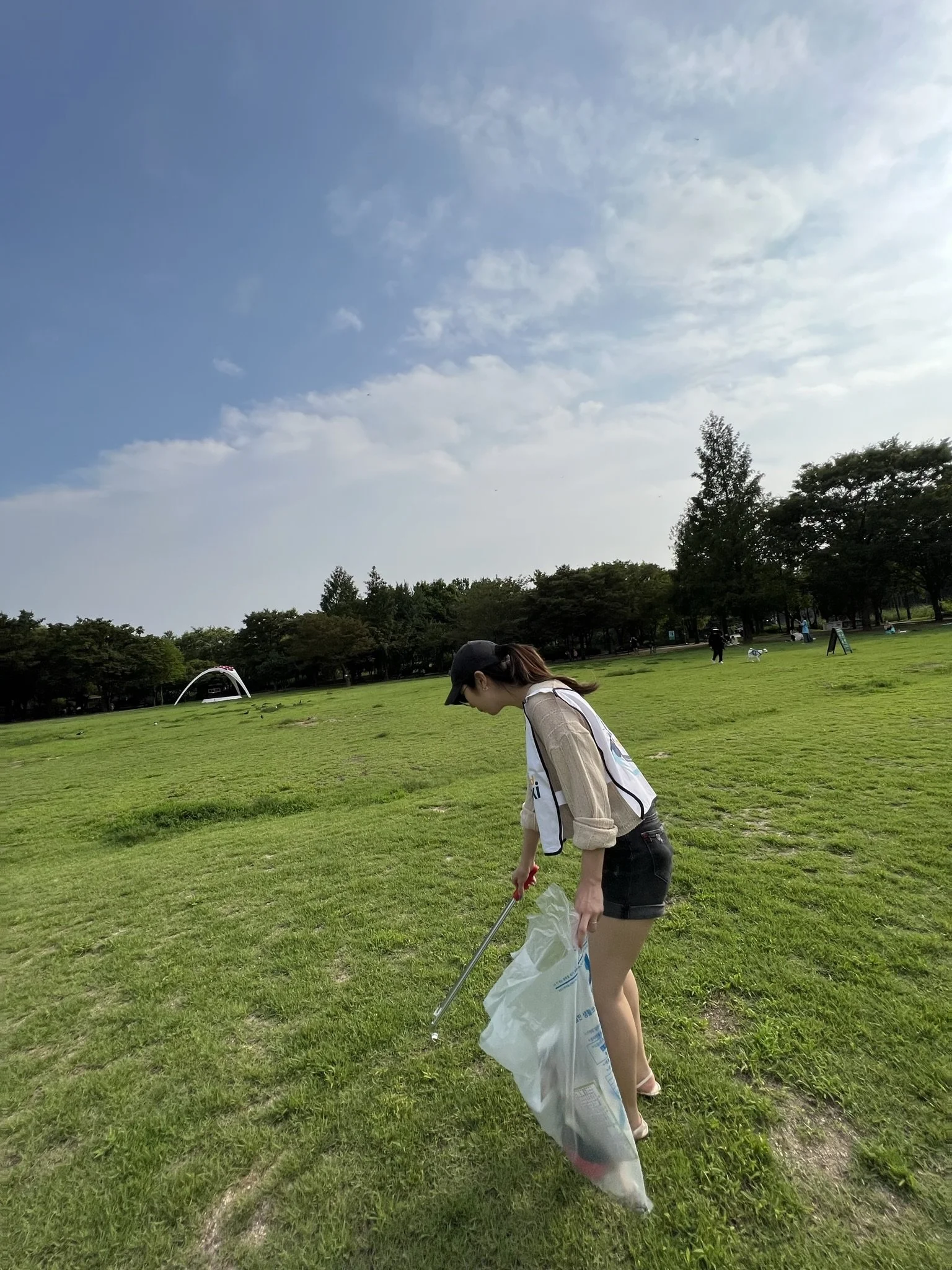
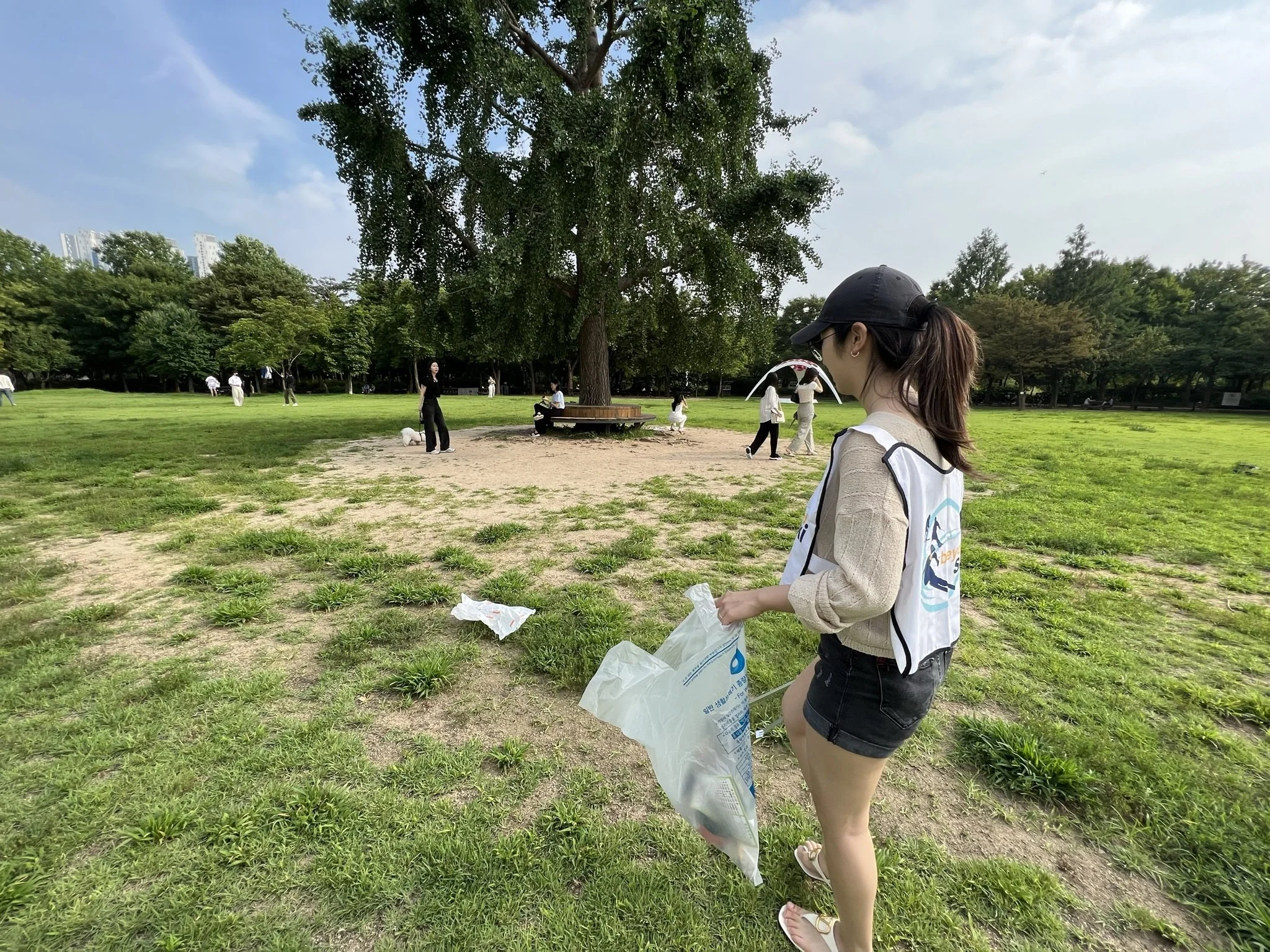
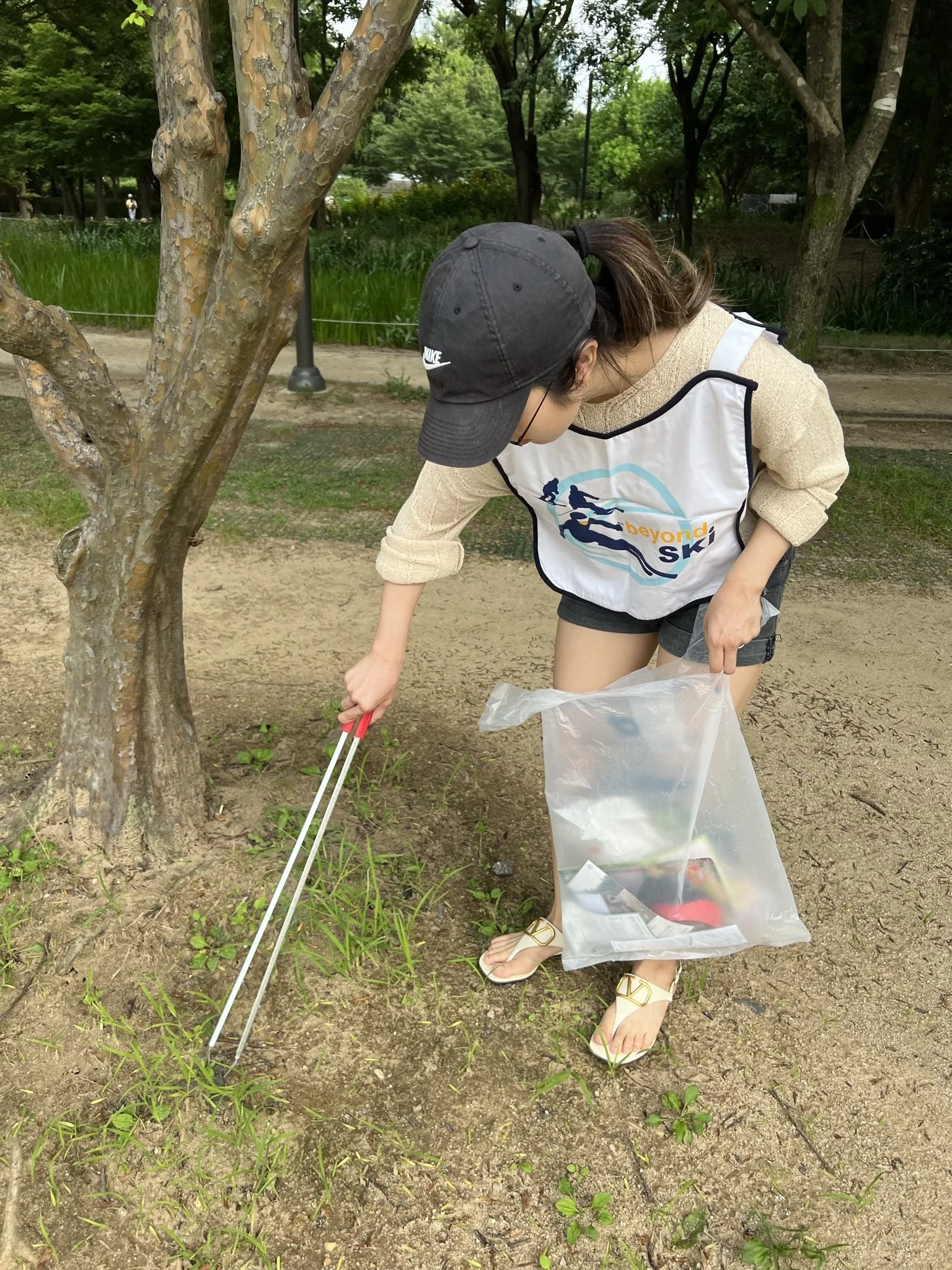


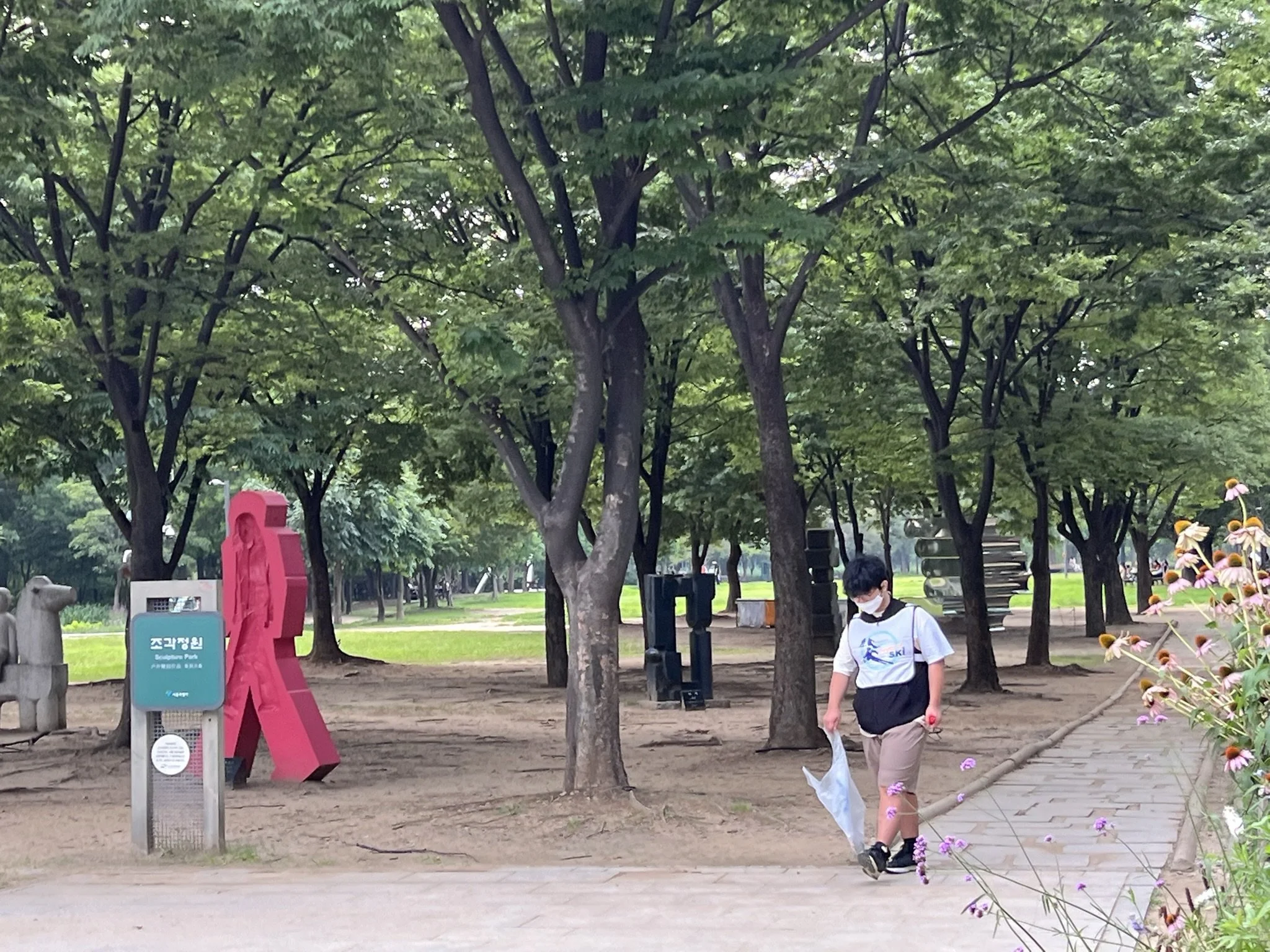

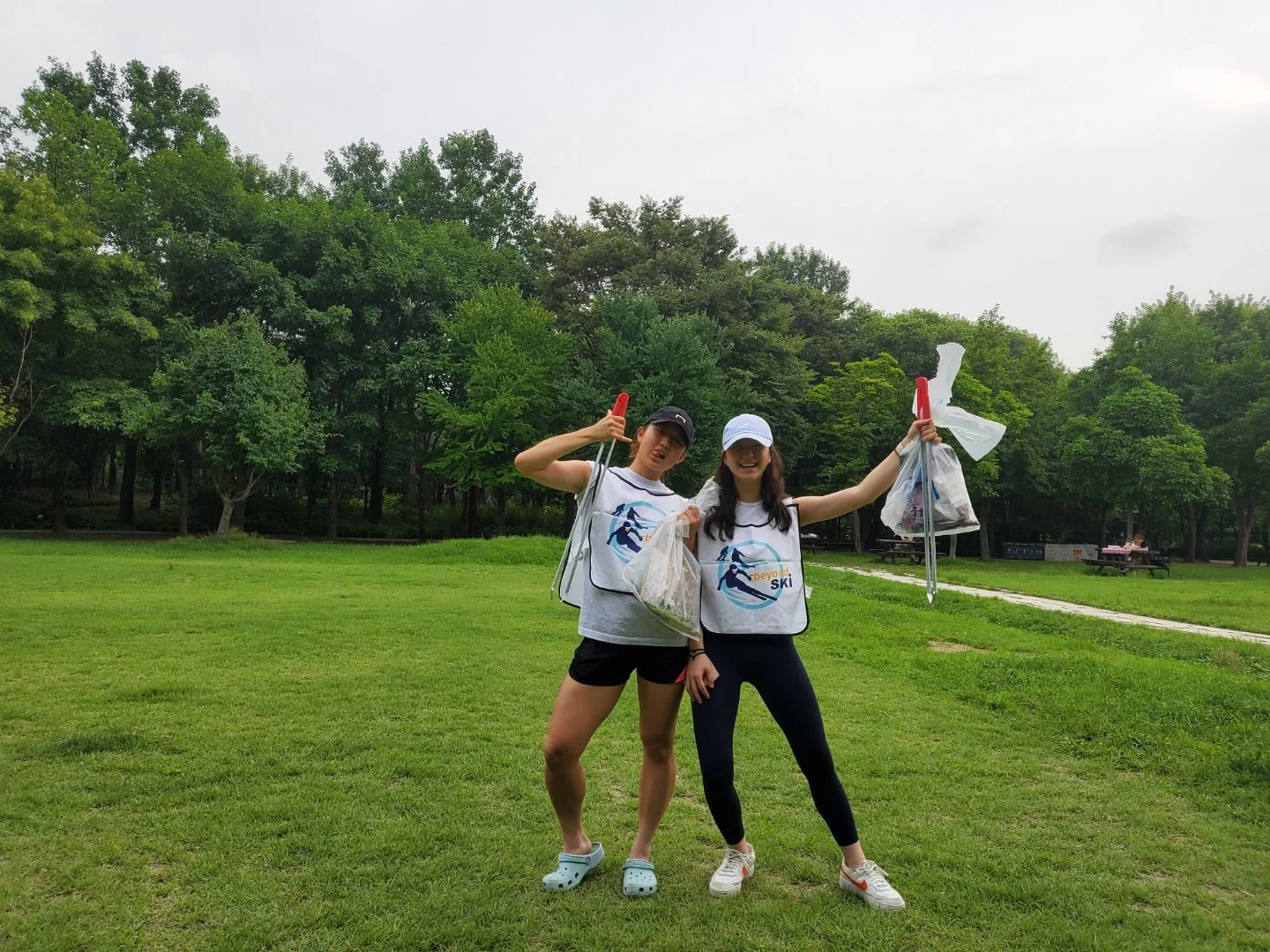
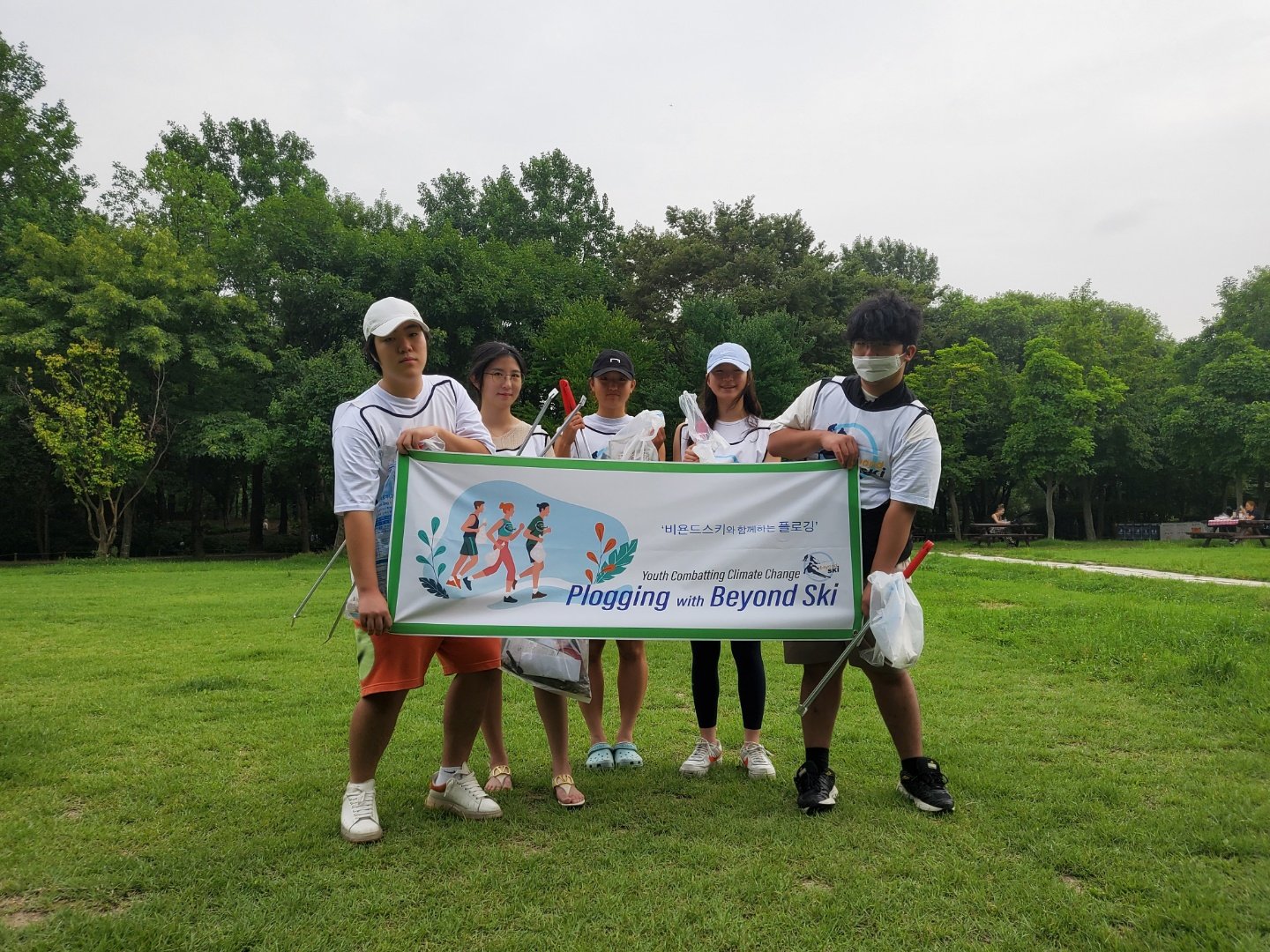
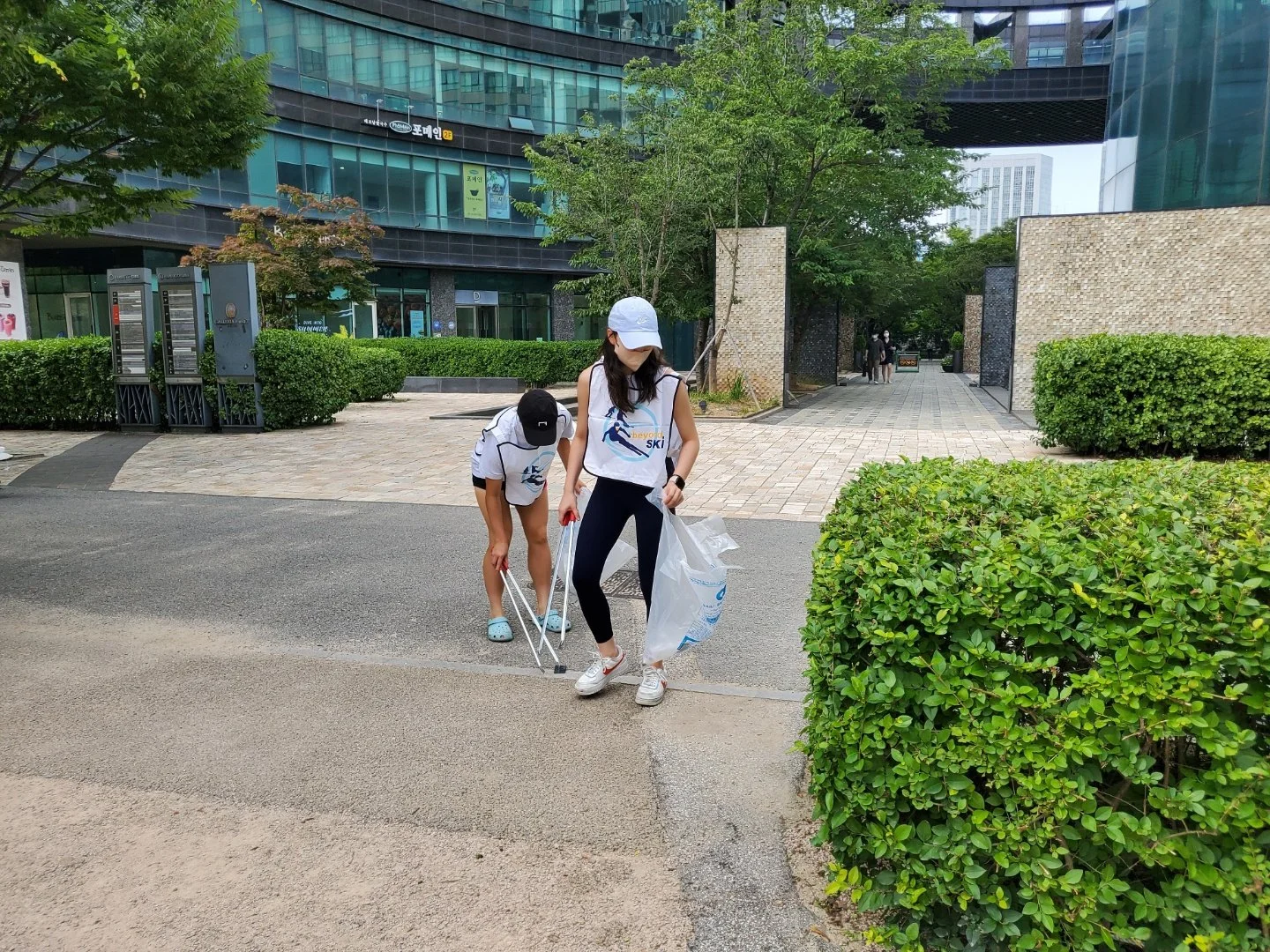
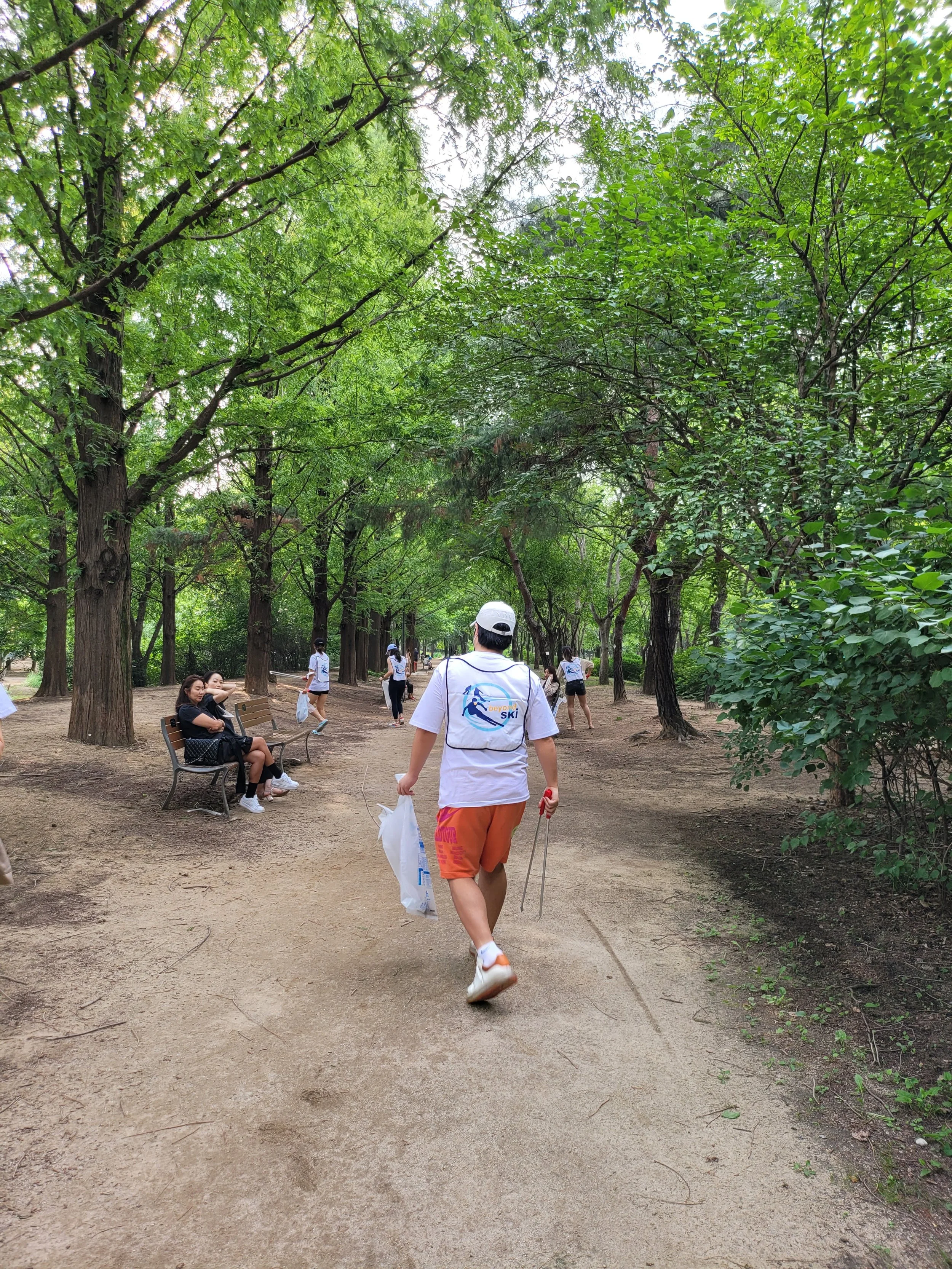
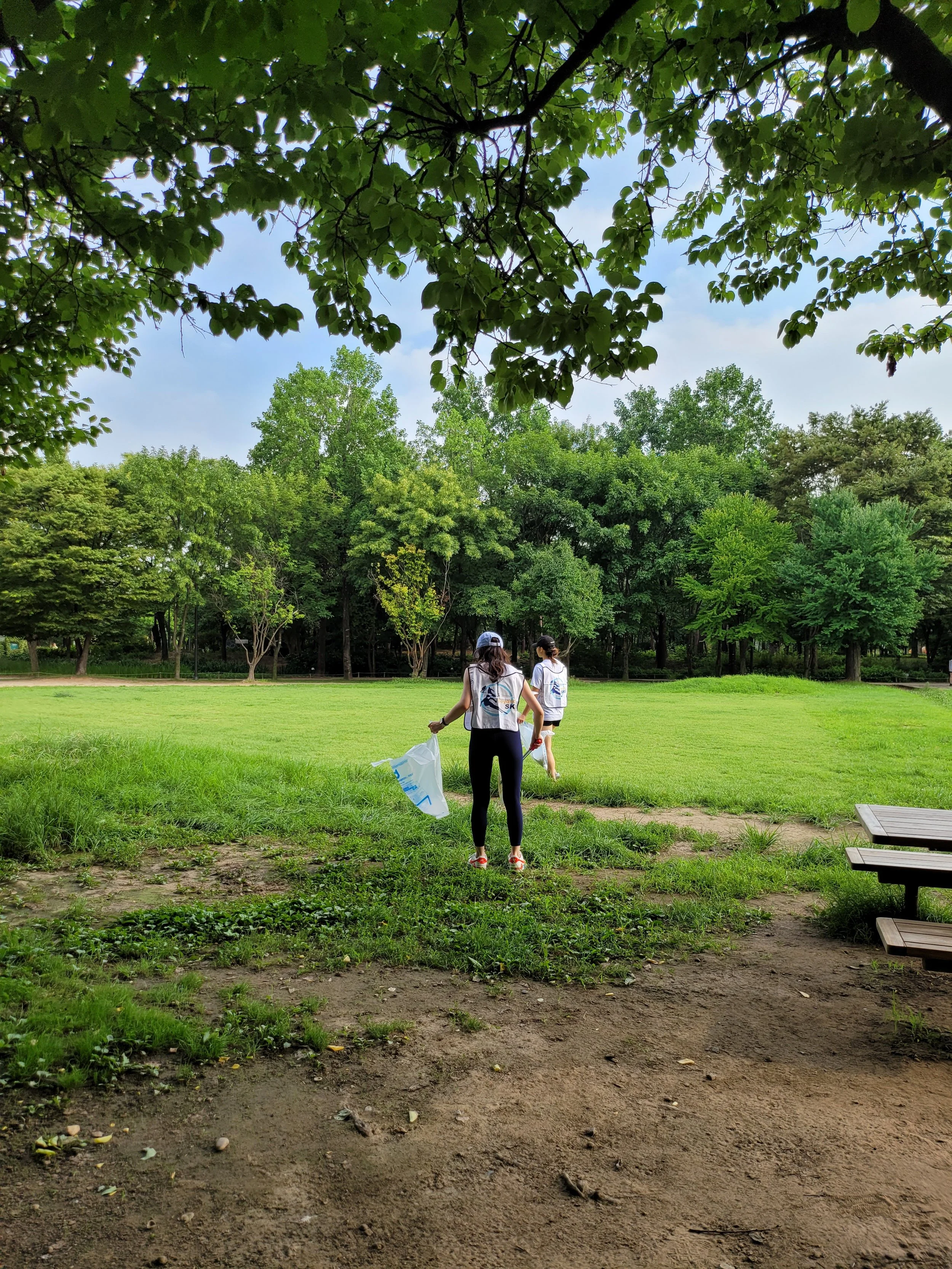
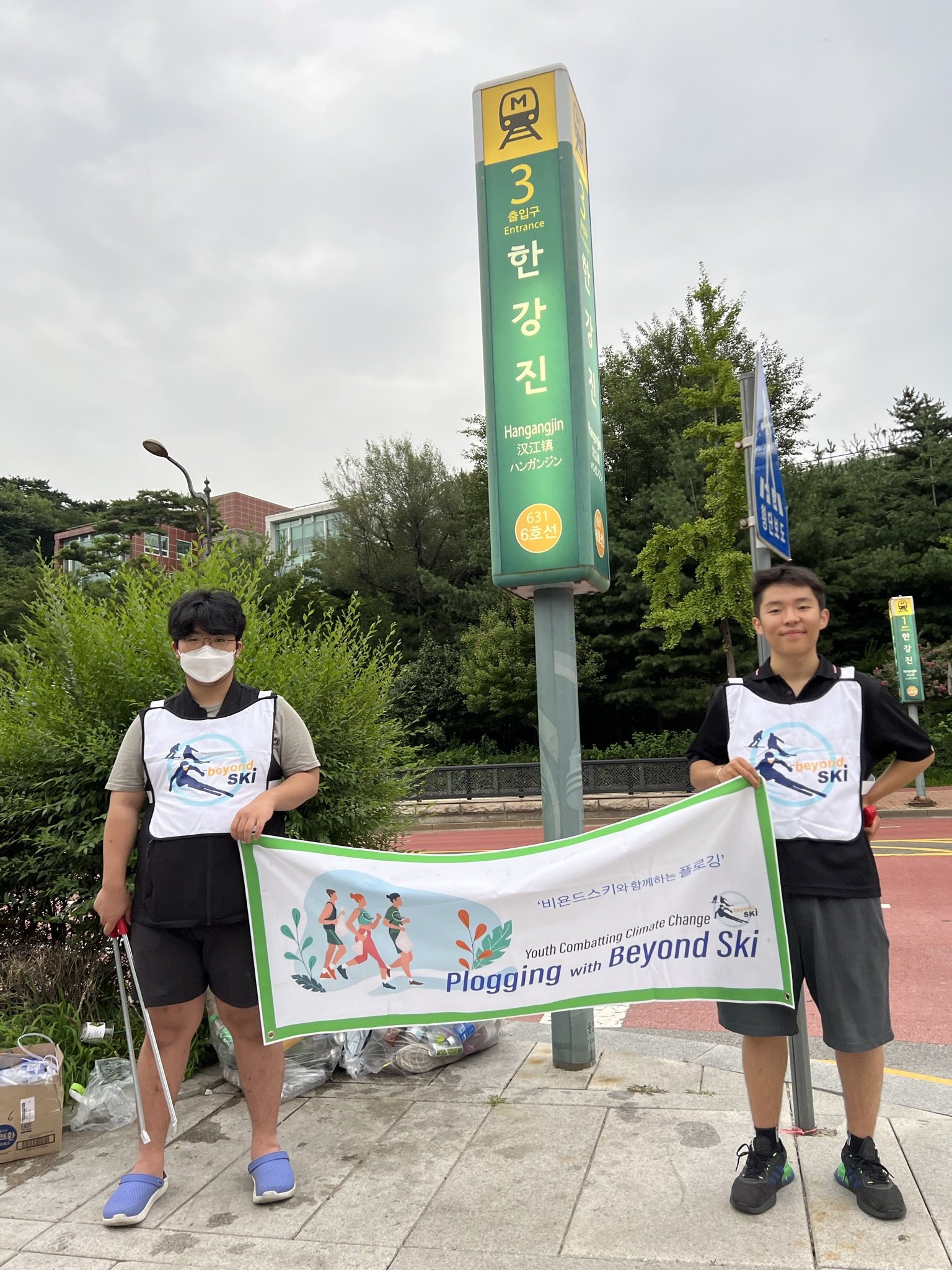
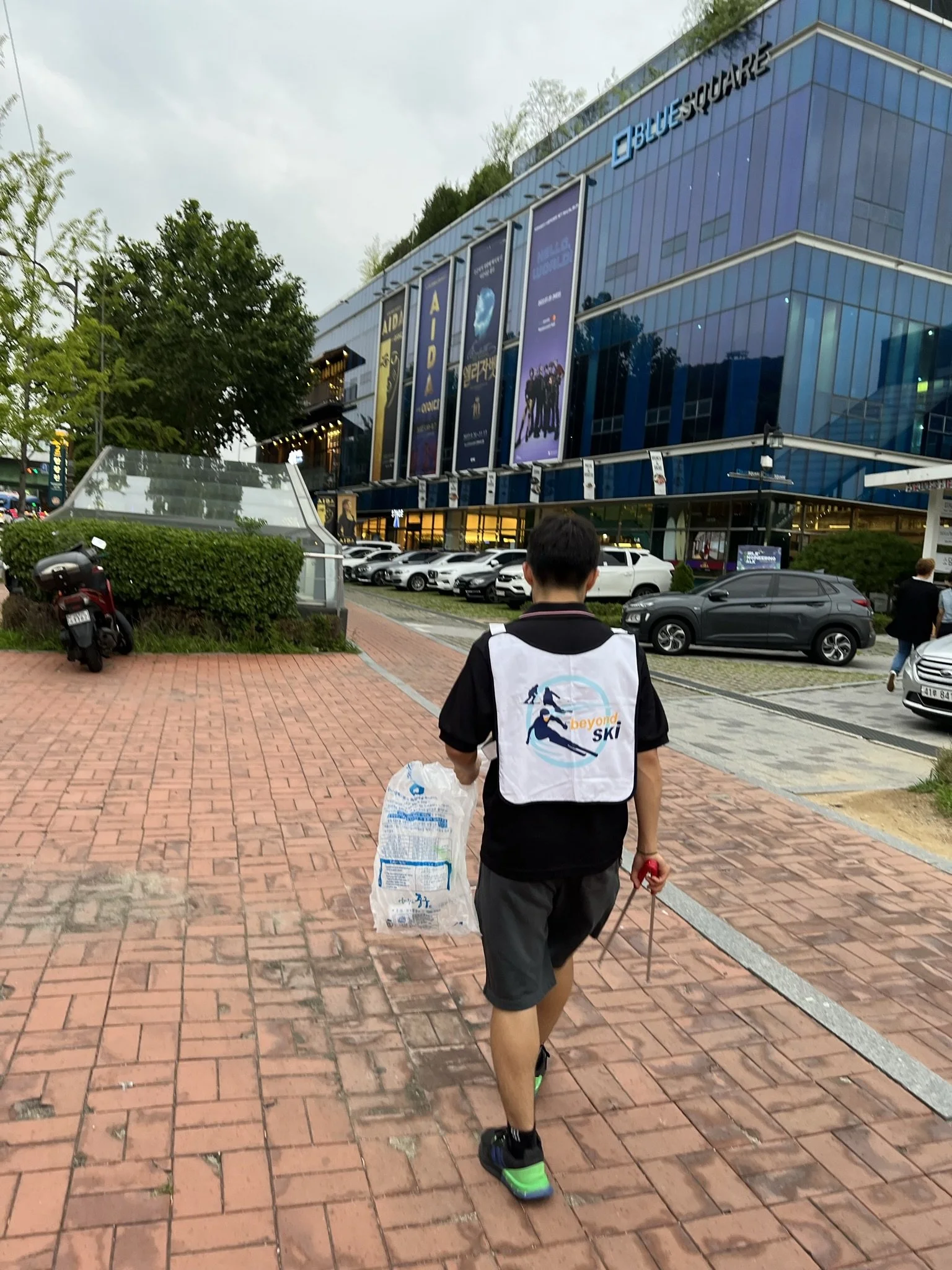
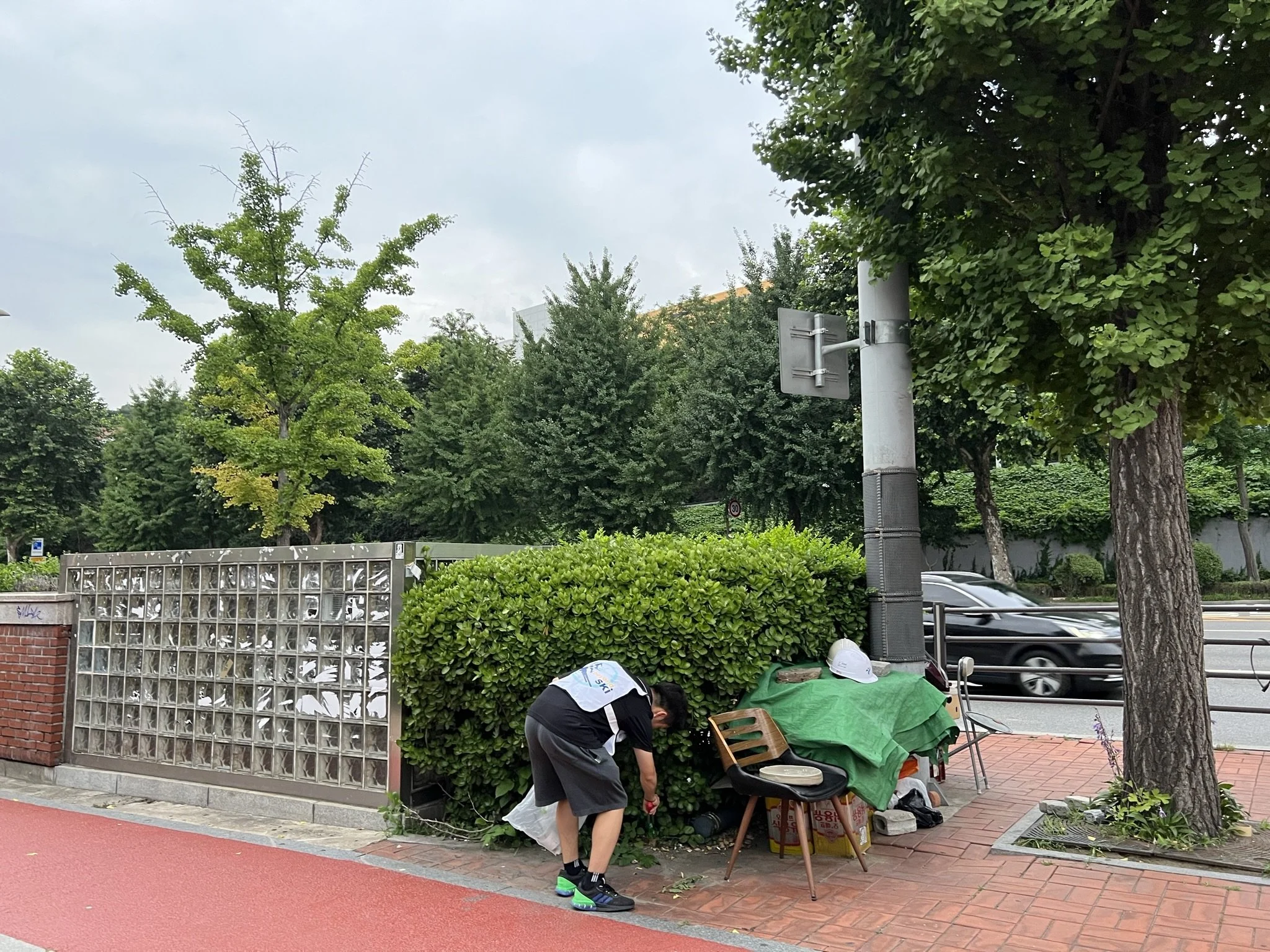
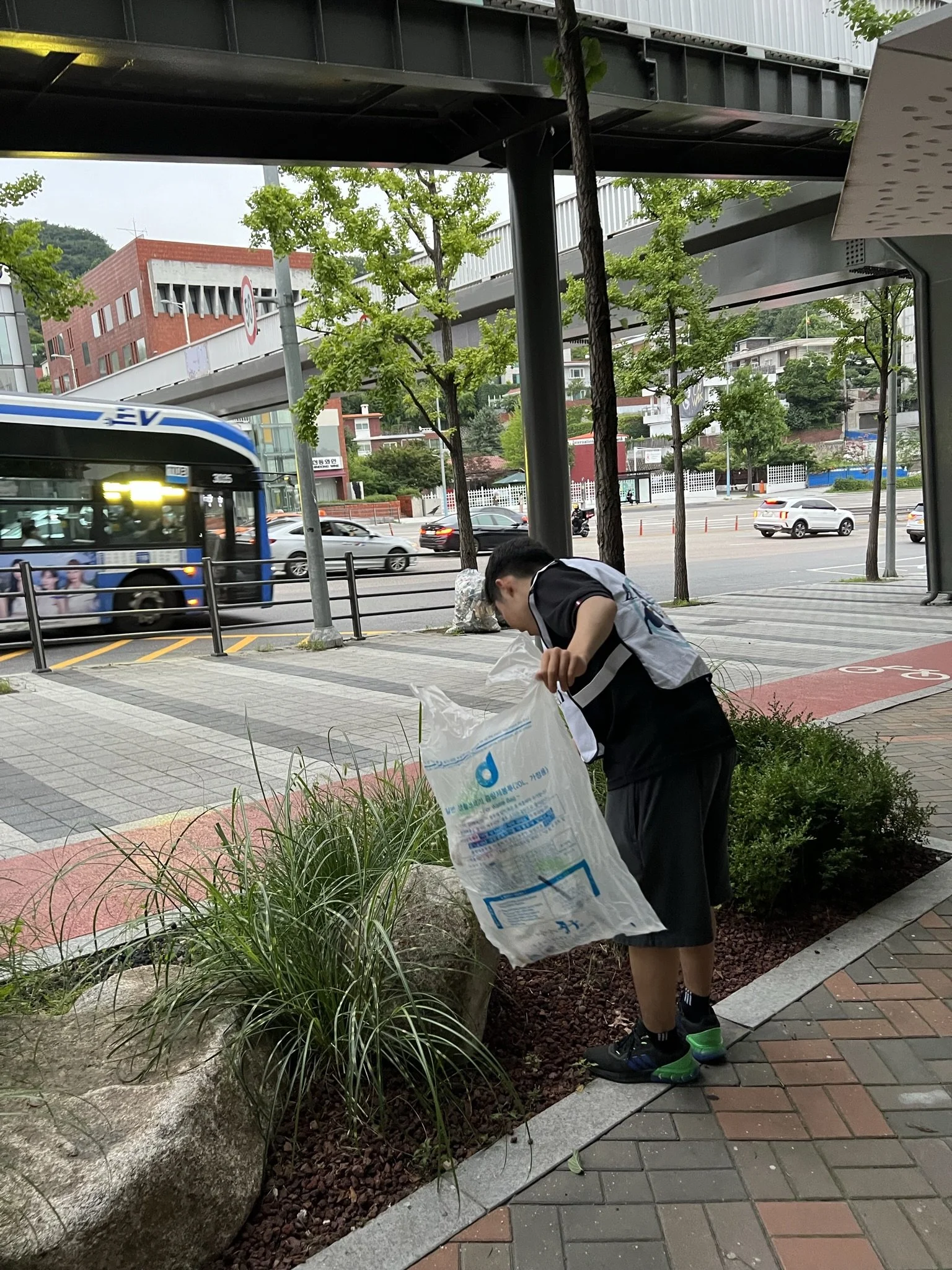
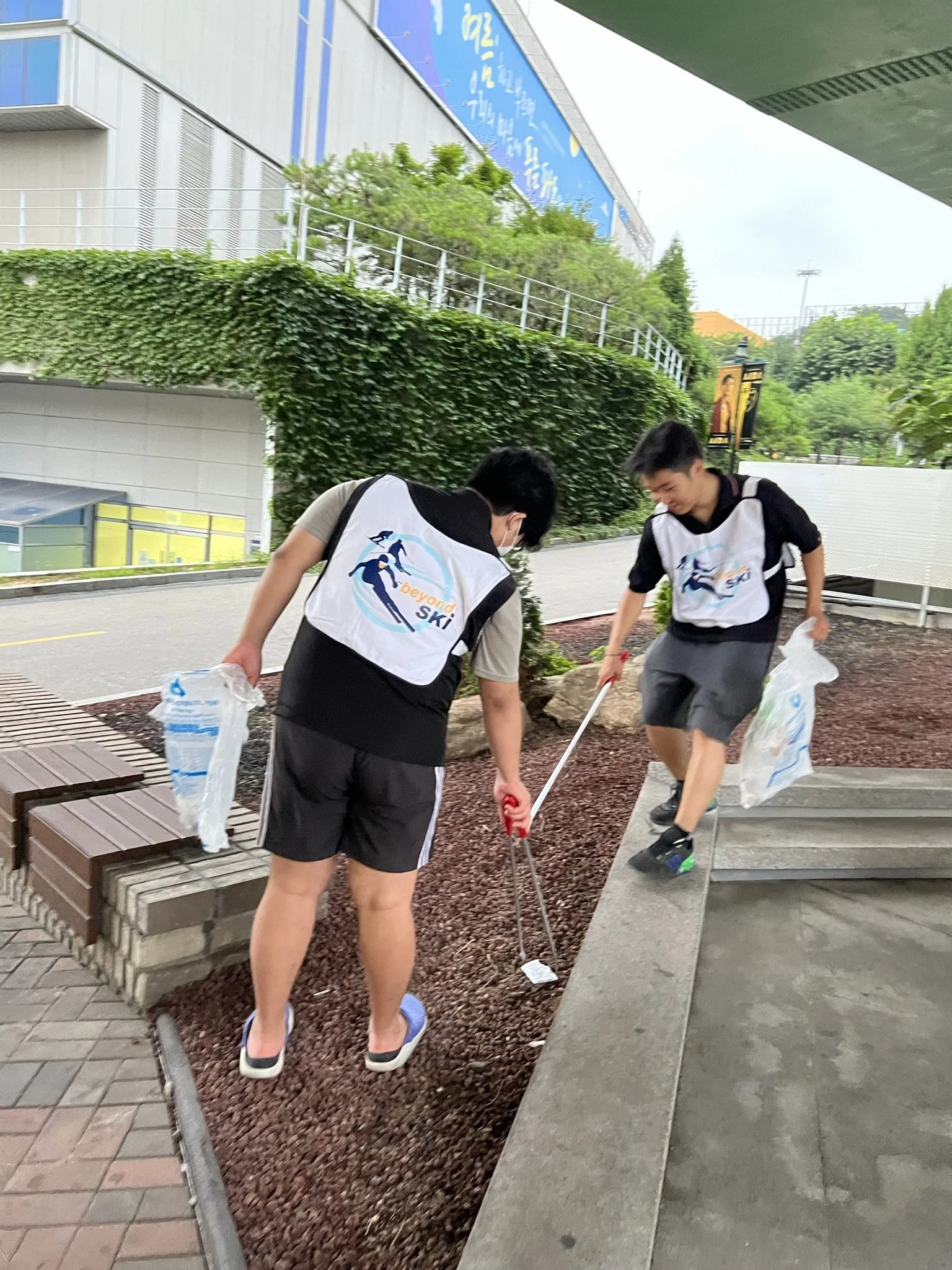

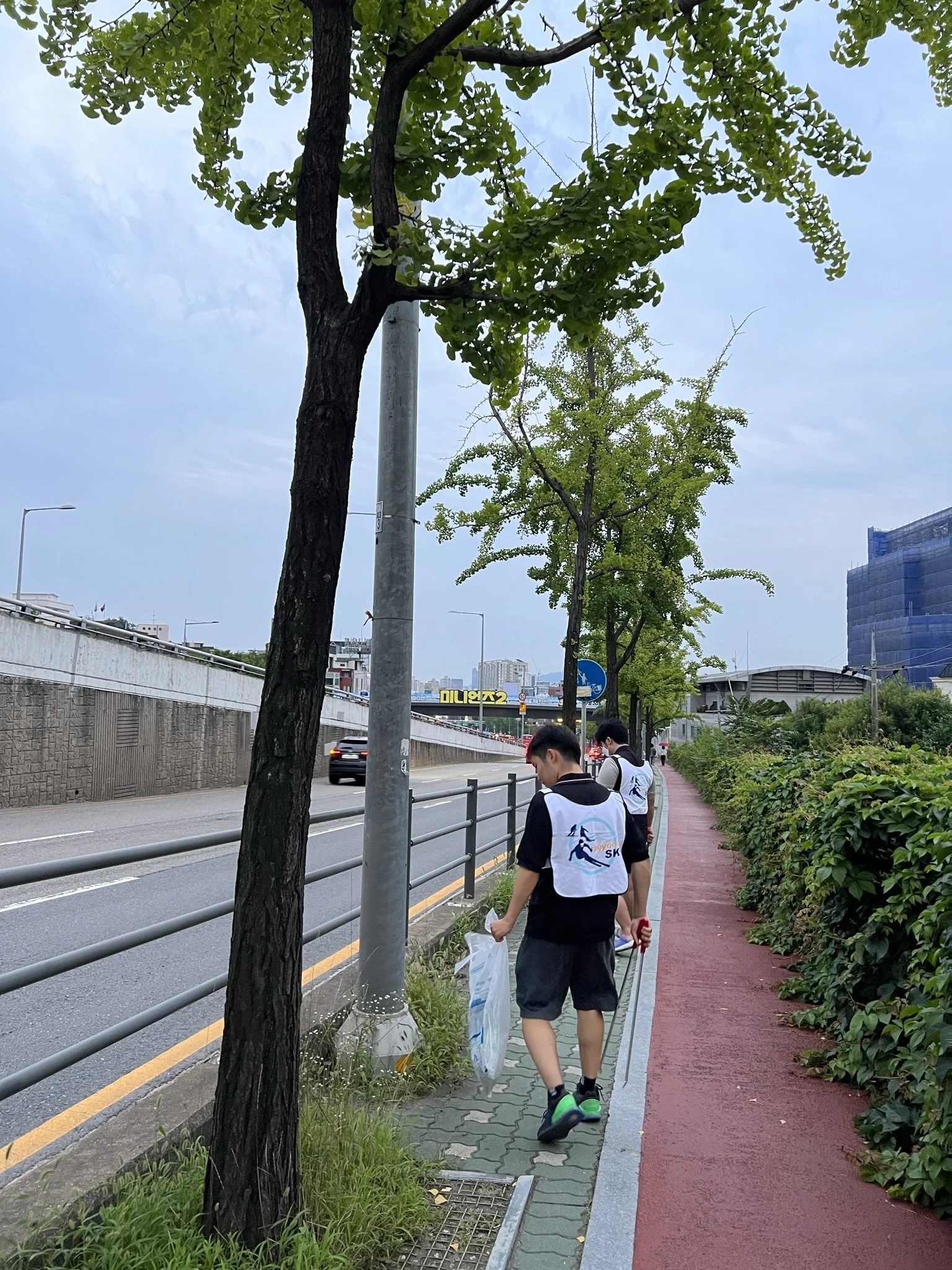
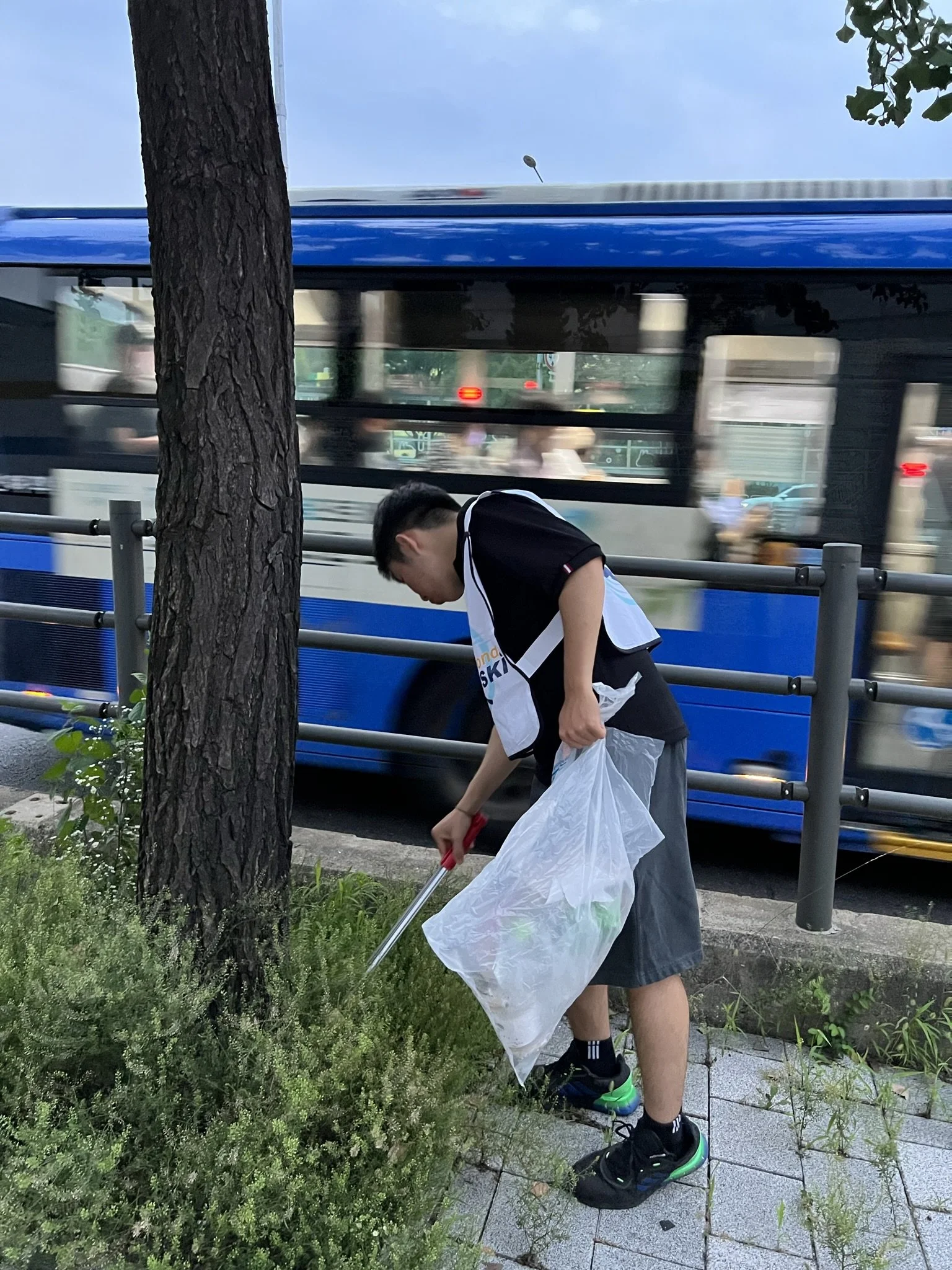
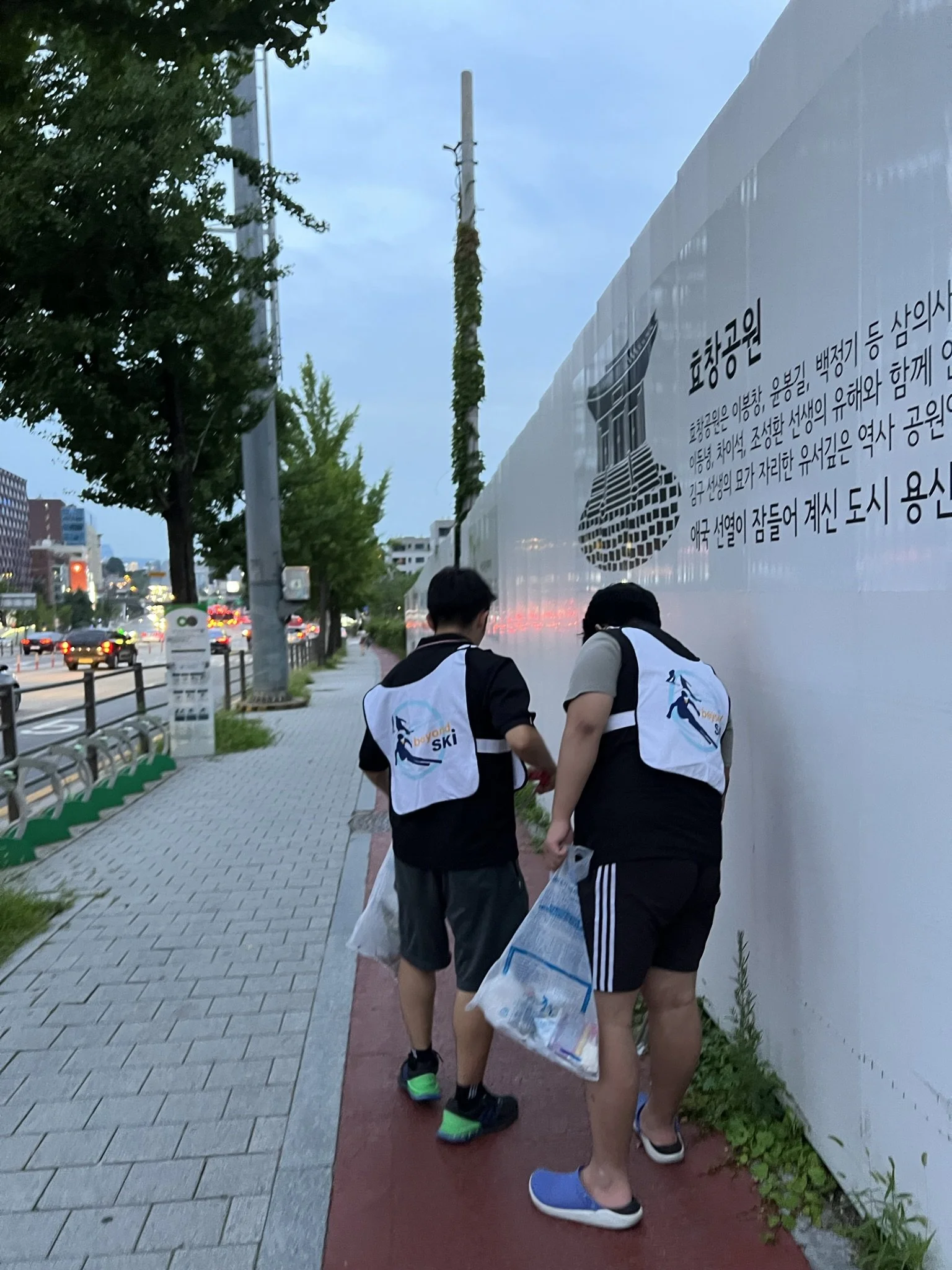
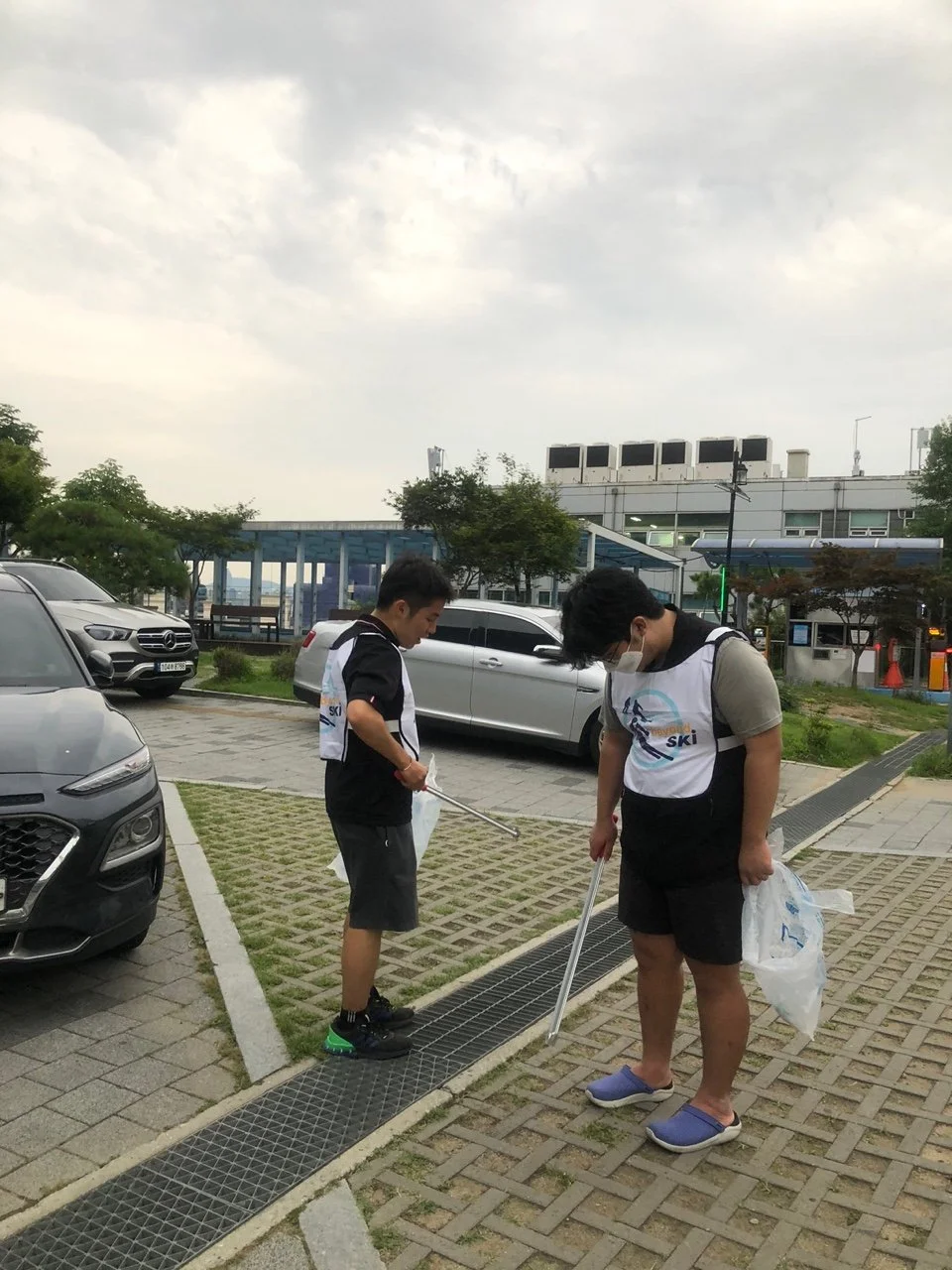
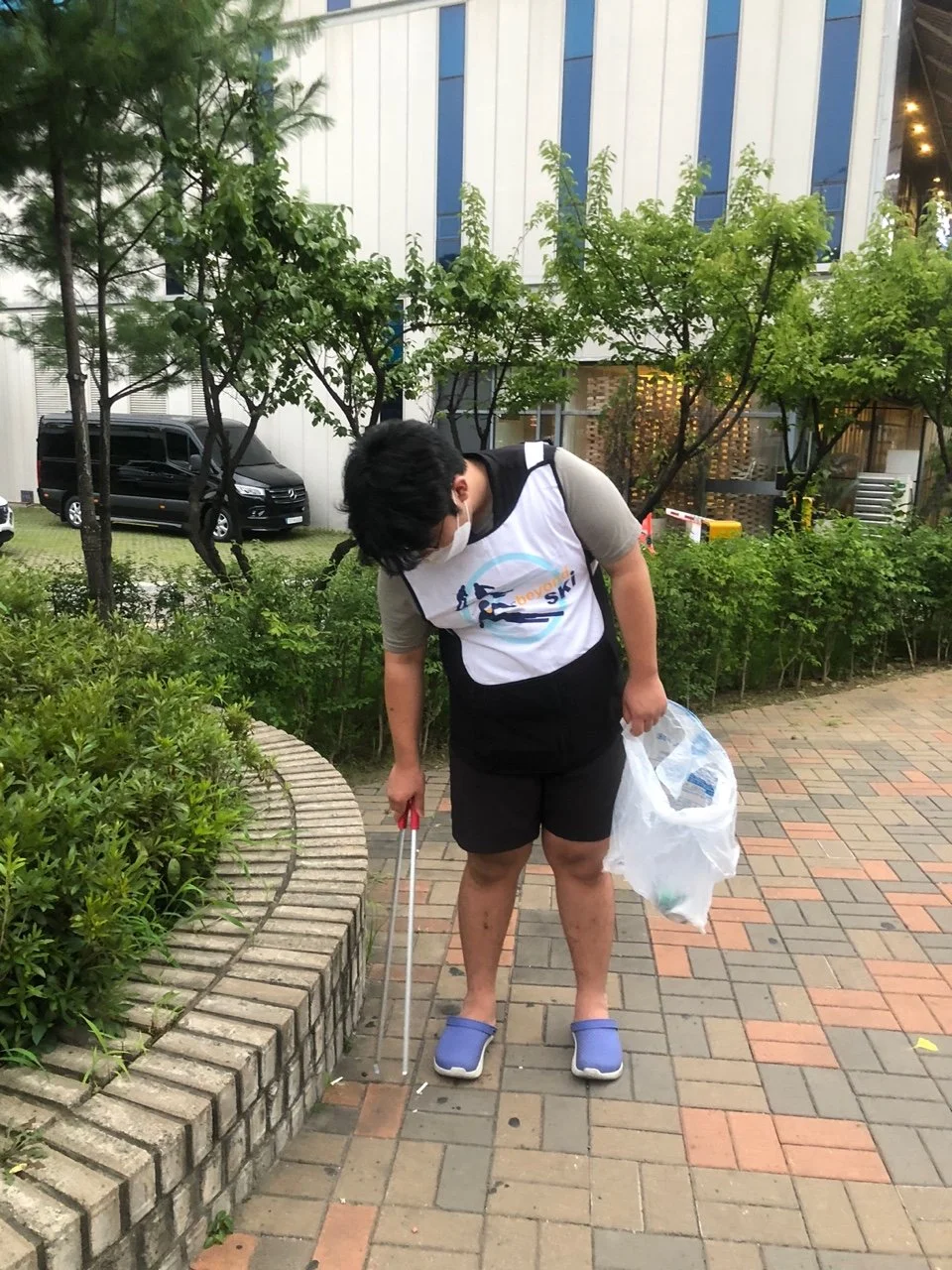

Campaign by creating and distributing environmental video
Beyond ski, an organization composed of skiers made a video regarding this crisis, and shed light on the importance of helping our planet by performing menial labor. It is necessary to acknowledge the condition of our world, and we, as humans, should take action on climate change. This video won the Best Award at the Young Reporters for the Environment competition organized by the Foundation for Environmental Education Korea in 2020.
Our Environmental
Action Journal
Eugene H. Shin
< Mask Tree>
We live in a world where masks have become a way of life due to the Covid-19. But did you know that these masks are becoming a major contributor to environmental pollution these days? I tried to show the seriousness of environmental pollution caused by the indiscriminate use of masks through photography. When discarding the mask, I separate the metal and string parts. If the mask ends up in the ocean, creatures have been known to snag on the string and die.
※ He won the Excellence Award in the photography category of the 2021 Young Reporters for the Environment competition, organized by the Foundation for Environmental Education Korea.
<Future of Energy>
The sun is an incredible and renewable resource that has the power to fuel life on earth and provide clean, sustainable energy to all its inhabitants. The sun shines all over the world, making solar electricity viable anywhere. Because solar can be paired with batteries for energy storage, solar electric systems can be independent of the utility grid, making them cost-effective for remote locations. Solar electricity relies on the sun as its fuel source, so there is no need to drill for petroleum-based fuels, refine them, or deliver them to the site. As you can see, there are a lot of advantages to solar energy.
※ He won the YRE Award in the photography category of the 2020 Young Reporters for the Environment competition, organized by the Foundation for Environmental Education Korea.
Katie Seoyun Kim
<Reusable Shopping Bags and Totes>
After watching A Plastic Wave, a documentary film on the effects of plastic pollution, and working with the Whale and Dolphin Conservation, a global conservation charity, I became determined to reduce my usage of single-use plastic bags. Through observation, I realized that the primary source behind plastic bag usage in my household was grocery shopping. Thus, I began carrying reusable shopping bags and totes when running errands—my entire family started to follow suit. While utilizing reusable bags may seem too insignificant to create any sustainable change, the relatively simple task has a tremendous impact. According to research conducted by the United Kingdom's Department for Environment, Food and Rural Affairs, an average shopper uses 13,000 plastic bags in their lifetime. By compelling three people to refrain from using plastic bags when shopping for groceries, I was able to prevent approximately 39,000 additional plastic bags from ending up in landfills or the ocean and endangering wildlife.
Although I was momentarily satisfied with my efforts, I soon recognized that the vast majority of Korean shoppers were continuing to use single-use plastic bags. I, therefore, felt the need to promote the use of reusable shopping bags. I gave a presentation in front of my school's World Wildlife Fund Club that highlighted the benefits of reusable shopping bags: not only do they benefit the environment, but they are also sturdier than typical plastic bags, meaning that they can hold more items. I now know how easy it is to forgo utilizing plastic bags, and I hope others realize that they can also develop sustainable habits that help the global environment.
William Kim
<My Sustainable Activity with a Refillable Water Bottle>
My sustainable activity involved something that I have been doing for years, which is using a refillable water bottle. Since I started going to boarding school, I’ve always taken advantage of the water fountains which are scattered around campus. These water fountains actually measure how much water they dispense and display a calculation of how many plastic bottles they have saved. Most of the water fountains at my school display a number anywhere between 30,000 and 100,000, which provides an excellent indicator of the impact that these fountains make. For me and many of my peers, this indication proves to us that we are making a difference and encourages us to continue this good habit. Combined with the stylishness of having a personal water bottle, these factors highly incentivize using a reusable water bottle at my school. Going back to the water fountain displays, I can estimate that the school has saved hundreds of thousands of plastic water bottles, which has definitely decreased our impact on local landfills and the environment. I am proud of my school and the contributions my peers make to be as sustainable as possible, and hope that more people have the opportunity to use a reusable water bottle with such ease.
Diana Oh
<Recycling of Food Container>
Throughout my boarding life at St. Mark’s, I tried my best to recycle as many items as possible by washing recyclable food containers before throwing them away. This action of washing my materials from contaminants increases the chance of them getting recycled, which causes less waste being discarded to the dumpsters. I was glad that I was able to actually make a change by something that required only a little effort.
Andrew Nam
< How to dispose the masks>
During the course of a couple of months, I started to cut the strings of my mask. While the front part of the mask cannot be recycled since it is both unhygienic and costly, the string part of the mask can be reused in a variety of ways. Personally, I disposed of this section of the mask in the recycle bin, where it can be recycled and made into eco-friendly items such as umbrellas and even shoes. From this experience, I learned that I can actually reuse parts of a disposable face mask. Many individuals would probably be unaware of this fact, as I’ve witnessed many dispose of their masks in the normal trash can. The main reason why throwing away them can be so detrimental is due to the fact that they can be hazardous to marine life. Much of the waste in the trash can eventually end up in the ocean, where sea animals are negatively impacted. However, by implementing an eco-friendly way of reusing masks, we can all help the world to be more green. All in all, this past experience made me realize the importance of recycling once again, and it allowed me to open my eyes to the millions of different ways recycling can take place.
Sophie Cho
<Paper Straws Challenge>
For the past week, I attempted to use only paper straws, rather than using plastic straws. Doing so contributes greatly and has a much more positive impact to the environment. While plastic straws are photodegradable, taking up to years to decompose, paper straws are biodegradable, requiring much less time to decompose. Also, plastic straws are notorious for harming wildlife animals, both on land and in the waters. On the other hand, if animals I gest biodegradable paper straws, it is much safer because it can be easily digested rather than clogging up the intestines. From the one week of using paper straws, I personally felt more helpful to the environment. It felt as if I was making a huge difference just by switching my choice of straw-from plastic to paper.
Hyoim Shin
<Disappearing Snow on Mt. Hood>
I am a ski racer. Since I was 3 years old, skiing has been a big part of my life. To enjoy my favorite activity, I traveled all around the world, including Mt. Hood in the US and Hintertux in Austria. But questions about my skiing career became dubious in 2015. My visit to Mt. Hood was quite different from past years. The peak beautifully decorated with white snow was unseen—rather, muddy grounds with rocks were clearly visible, making it utterly impossible for skiing. This was when I started to ask myself: what is happening to winter? Is “heat” really something that we should worry about?
If we closely take a look at the Earth, global warming is not merely warning humanity of melting mountains. In fact, increasing Earth temperatures have resulted in frequent “heat waves,” which are prolonged periods of abnormally hot weather. Such weather transformations directly pose a dire threat upon human health. A human body’s internal temperature is normally between 36 to 37° Celsius. However, if internal temperature becomes close to 40° Celsius, which can be caused by heat, all-important cellular machinery starts to break down, even injuring the brain, heart, kidneys, muscles and other organ functions. This means that “heat” is not a trivial factor that causes simple dizziness and fainting. It is responsible for threatening lives, especially those of elders, babies, patients, outdoor workers and those living without air conditions. This severe situation is proven in dozens of devastating “heat waves” that have struck the world. The combination of high humidity and high night-time temperature was responsible for 70,000 deaths in Europe (2003) and 55,000 deaths in Russia (2010). In India, casualties from heat waves have increased 2.5 times between 1960 and 2009, despite the fact that India has only seen 0.5° Celsius rising in the past 50 years. Besides these examples, there are numerous more cities that annually suffer from “heat waves” that are occurring more often than ever.
Moreover, extreme heat is quickening the spreading of various deadly diseases as warm climate facilitates the activities of viruses. Among infectious diseases, there are two kinds that are the most worrisome. First, vector-borne diseases, caused by pathogens usually transmitted by mosquitoes, are currently on the rise as warm weather increases pathogens’ survival rate and accelerates its production through reduction of incubation period. Consequently, mosquitoes thrive by increasing various diseases, such as malaria, dengue fever and Japanese encephalitis, which all contribute to fatal deaths. For instance, malaria alone threatened 216 million people in 2016, killing 445,000, mostly children in Africa. Second, extended heat also raises the possibility of water and food-borne diseases through increasing microorganisms, fungi and bacteria. Heat will activate their activities, which will increase the prevalence of salmonella and cholera. Such infectious diseases are already on the rise in especially poor nations where they do not have solid social infrastructure that promotes education on sanitation. Thus, mere rise in heat will further devastate poor and uneducated people’s lives through various illnesses resulting from water and food that they eat every day.
The only home that we live in is definitely becoming hotter, even at this moment. Without actions done, this “heat” will not only destroy specific winter-related industries, but rather cause much further devastation—a direct threat upon the existence of humanity. With every global citizen taking a part in rescuing the Earth, we all must stop this “heat” from rising, through every measure that we can possibly take.




